Urban exploration at the abandoned Soviet sanatoriums in Tskaltubo – hotels and resorts, bathhouses, mosaics and more
We have updated this post with every place we have discovered during our multiple visits. With 19 sanatoriums and hotels and 6 bathhouses featured, along with a sizeable list of other (mostly) Soviet-era locations that caught our eye, what follows is now one of the most comprehensive guides to Tskaltubo available online.
Note; It will take two, possibly three full days to see everything listed below. If you only have limited time, our recommended Tskaltubo ‘must-sees’ are Sanatorium Metalurgi, Sanatorium Medea, Hotel Aia (for the mosaics), Bathhouses #6 & #8, the railway station, Sanatorium Iveria, and Sanatorium Shakhtiori (if you can gain entry). This post was first published 25 July 2018
TABLE OF CONTENTS – EVERTHING YOU’LL FIND IN THIS GUIDE
Introduction to TskaltuboHistory of Tskaltubo
Responsible tourism in Tskaltubo
Location Map – Where to find Tskaltubo’s Soviet-era sanatoriums and spas
Safety in Tskaltubo
Stray dogs in Tskaltubo
How to get to Tskaltubo
Where to Stay in Tskaltubo
Things to see and do in Tskaltubo
Sanatoriums & HotelsBathhouses & Spas
Other Places of Interest in Tskaltubo
Many of the former sanatoriums and health resorts in Tskaltubo are open and accessible, their sweeping stone staircases and ornate entrances easily visible, tempting curious passers-by like us to take a closer look. But not all are abandoned…
Today Tskaltubo is one of the most-visited abandoned places in Georgia but, as part of the USSR, it was a popular spa resort, famous for its healing mineral waters and radon bath treatments. Most visitors reach the small town by a short marshrutka (fixed route minivan) ride from the historic city of Kutaisi in western Georgia but, in its heyday, thousands flocked from across the Soviet Union and there were up to four daily trains from Moscow.
Tskaltubo’s Soviet-era sanatoriums and bathhouses are often described as abandoned but, that doesn’t really tell the whole story. Although many of the grand buildings are in ruins, some of the bathhouses are still in use, many of the hotels have been repurposed to house refugees from Abkhazia, there are several hotels and guesthouses catering to visitors, and one of Tskaltubo’s most impressive hotels has been (partially) restored to its former glory. Furthermore, Tskaltubo is a working town with a busy market and other services commonplace in other Georgian settlements.
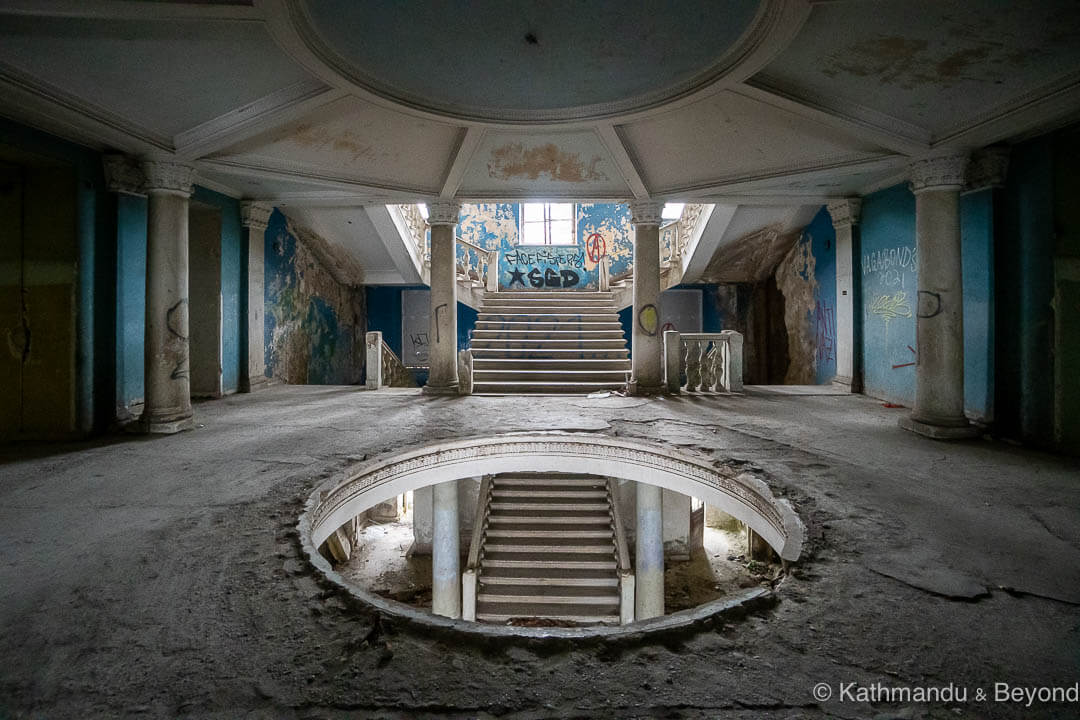
A short history of Tskaltubo
The first bathhouses are believed to have opened in 1870, and in 1925 the first sanatoriums and in-patient facilities were built. Development continued and in 1931 Tskaltubo was designated as a balneotherapy* centre and spa resort by the Soviet government and it was one of Stalin’s favourite vacation spots. During WWII, the hotels were used as hospitals but after the war, their popularity increased and by the ‘80s Tskaltubo was one of the most sought-after tourist destinations in the Soviet Union, in close competition with the many other resorts dotting the Black Sea coast.
* Balneotherapy is the treatment of disease and medical conditions by bathing in mineral-enriched water. From the Latin balneum meaning bath.
There were around 5,000 or so beds in 19 hotels and sanatoriums (some sources say 22) built in a ring around Tskaltubo Central Park, also referred to as Tskaltubo Mineral Water Park, where the baths and thermal springs are situated in an area known as the balneology zone.
Back in the day, a spa break wasn’t a pampering holiday afforded only by the wealthy; it was a prescribed, and mostly compulsory, annual respite – the “right to rest” was inscribed in the Russian constitution. Under the communist regime, a visit to the doctors could result in being dispatched to somewhere like Latvia or Georgia where spa towns were renowned for the healing properties of their mineral waters. Or, if you were super lucky, to Kazakhstan to be bathed in warm crude oil!
At the height of its spadom, up to 1,500 people per day were taking treatments at Tskaltubo. Today the numbers are a fraction of that but the Georgian government is looking for investors to help restore Tskaltubo to the grandeur of its bygone days. It’s going to be a slow process. Some of the sanatoriums in Tskaltubo were sold off at auction as recently as the summer of 2022 but apart from the odd fencing off of certain properties, namely Shakhtiori and Iveria, we have noticed very few changes since our first visit in 2018. But, if and when it happens, much of the remaining remnants of intricate detail and the photogenic urban decay are likely to be lost to memory and photographic records.
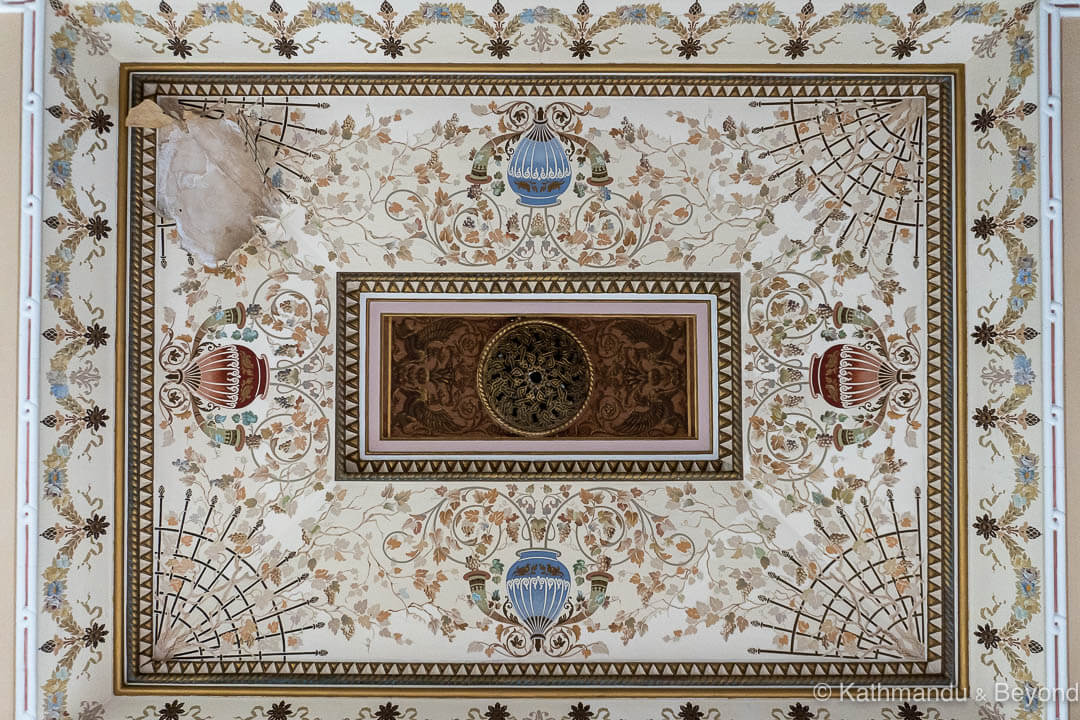
Georgia’s independence in 1991 and the fall of the Soviet Union in late December 1991, signalled the collapse of Tskaltubo’s spa industry. Without guests, most of the hotels and resorts were forced to close their doors.
During the 1992/1993 Georgia-Abkhazia conflict, some of the by-then abandoned properties were used to house Internally Displaced Persons (IDPs). Over 200,000 people fled from the breakaway region of Abkhazia and 8,000 to 9,000 of them were given refuge in Tskaltubo where there were many empty hotel rooms. It was supposed to be a temporary arrangement but decades later, these makeshift apartments have become permanent homes for new generations of families. The condition of the buildings occupied by IDPs are extremely poor and although basic utilities are connected, kitchen facilities mostly consist of a single portable gas burner and there are no funds for routine maintenance.
This short video from the BBC entitled Tskaltubo: Georgia’s abandoned resort that refugees call home is a good bite-sized summary of Tskaltubo’s past and present.
Responsible tourism in Tskaltubo
It is imperative to be respectful when visiting buildings in Tskaltubo that are occupied by IDPs, which is actually quite a few of them. A degree of self-consciousness also wouldn’t be a bad thing. Waltzing in, all guns blazing (or cameras clicking) is not a good approach. We have been to more than our fair share of abandoned locations and we find it always pays to be cautious and maintain radio silence until at least we know the lay of the land.
Tskaltubo has grown in popularity as a destination for urban exploration since we originally wrote this post in 2018. As we testify below with the odd anecdotes, our interaction with IDPs back then was always positive. It pleases us to say that the same can be said when we spent time there in early 2022 – we got greetings, smiles and waves as part of the course. But, that’s not to say this will always be the case. It only takes a couple of bad experiences with less sensitive visitors and the local population could start taking a more negative attitude toward tourists poking around.
There are a few considerations, which are mostly just common sense, that are worth adhering to when planning a visit to Tskaltubo;
- Know a little of the history of Tskaltubo and why it is home to so many IDPs
- Be polite and smile at anyone you may meet
- Don’t go into areas that are clearly occupied by IDPs
- Don’t photograph people unless they give you permission
Map of locations – Where to find Tskaltubo’s Soviet-era sanatoriums and spas
Safety in Tskaltubo
Is Tskaltubo safe to visit?
We have never heard of any incidents involving visitors, such as robbery or intimidation, for example, taking place in Tskaltubo. Plus, we have always felt quite safe while exploring the place.
It goes without saying, however, that going into abandoned buildings comes with a long list of perils and you do so at your own risk. Uneven surfaces, debris, broken glass and, our personal favourite (not!), exposed stairways are but a few of the hazards you need to be wary of. What’s more, many of the abandoned sanatoriums are also damp and thus wet and slippery underfoot. The remains of wooden flooring are often on the verge of rotting. Wear sturdy footwear and regularly look down at your feet to see where you are treading would be our advice.
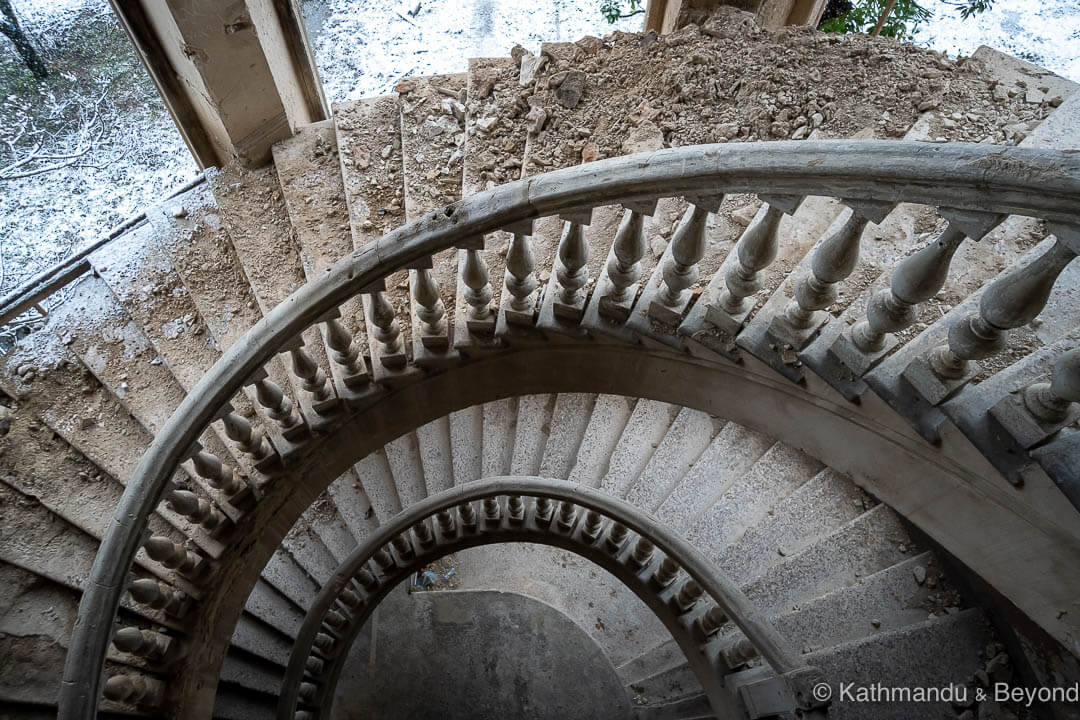
Stray dogs in Tskaltubo
For some reason, don’t ask why, but it is not uncommon to be accompanied by a street dog or two as you pound (get it!) the streets in Georgian towns. But, in Tskaltubo this is taken to a whole new level and, from our experience and that of others, it is not unusual to be joined by a small pack of canines as you go about your urban exploration.
I guess your attitude to this depends on how comfortable you are around dogs. We are both very happy in the company of dogs and so it doesn’t bother us. We also know that stray dogs in Georgia are neutered which means they are quite docile. So, generally, we don’t have a problem with them attaching themselves to us. The only time ‘your’ dog(s) might get a bit shouty in Tskaltubo is when another dog approaches (territorial) or they decide to run off and chase passing cars (bloody stupid and cringe-worthy to watch sometimes!), which seems to be a favoured pastime for the town’s strays!
We tend to pat and encourage them but if you ignore them they are likely to move on in search of another human to befriend.
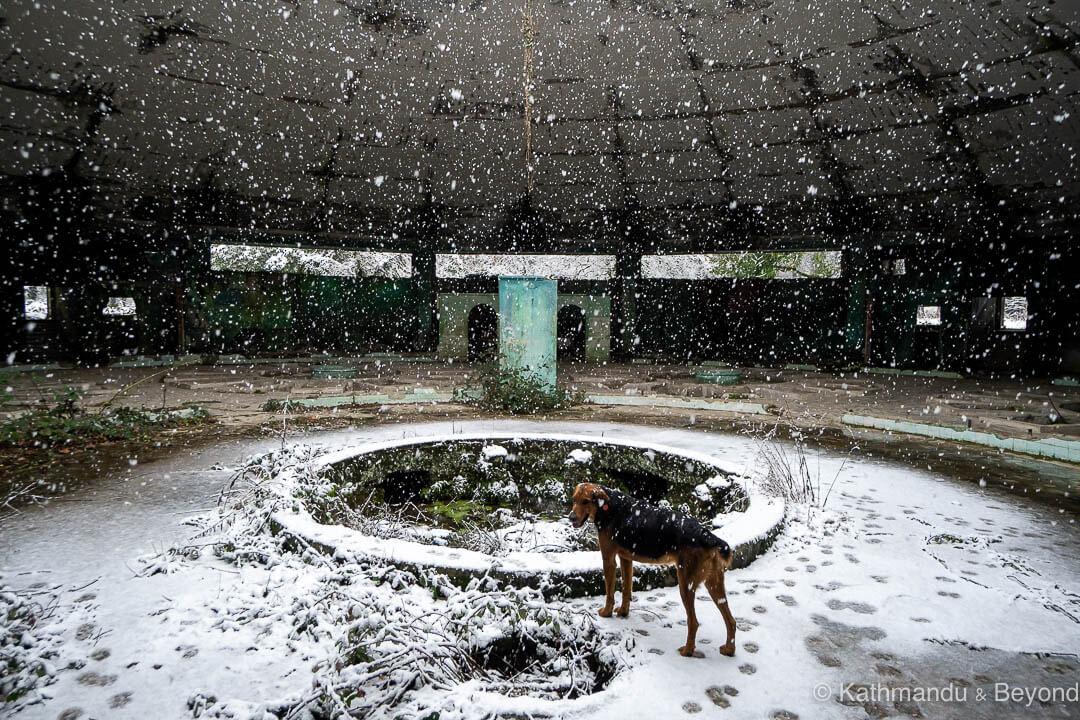
How to get from Kutaisi to Tskaltubo
The best way to reach Tskaltubo from Kutaisi is by marshrutka. The distance is approximately 15kms and the journey time is around 20 minutes. Assuming you are staying in downtown Kutaisi, the most convenient marshrutka is #30 which leaves from the other side of Red Bridge, near the Monument to Galaktion Tabidze. They depart approximately every 20 minutes between 8am and 7pm and the fare is 2 GEL. There is also marshrutka #34 from the main bus station. They depart once an hour and the fare is also 2 GEL.
How to get from Tskaltubo to Kutaisi
Marshrutkas enter Tskaltubo via the western side of Central Park and depart via the eastern side. Hence, if you plan your day to end on the eastern side of the park you can flag down a passing marshrutka to take you back to Kutaisi. They pass by regularly and the fare is the same.
Wherever you are coming from in Georgia, be it Tbilisi or Batumi for example, you will have to change transport in Kutaisi to get to Tskaltubo.
Where to Stay in Tskaltubo
Because Tskaltubo is only 8 or 9 kilometres from Kutaisi, there is no need to stay in Tskaltubo. There are several guest houses and hotels in Tskaltubo but if you’re on a budget, Kutaisi has more choices. If you’ve got a bit more to spend, you could experience a night or two at a former Soviet sanatorium, the Tskaltubo Spa Resort – a double room including breakfast is usually around £63/US$71/€72 per night. You can also book packages that include spa treatments.
Kutaisi has a wide choice of accommodation. We’ve stayed at a few places and our favourites are Nana’s Place and Guest House Rioni.
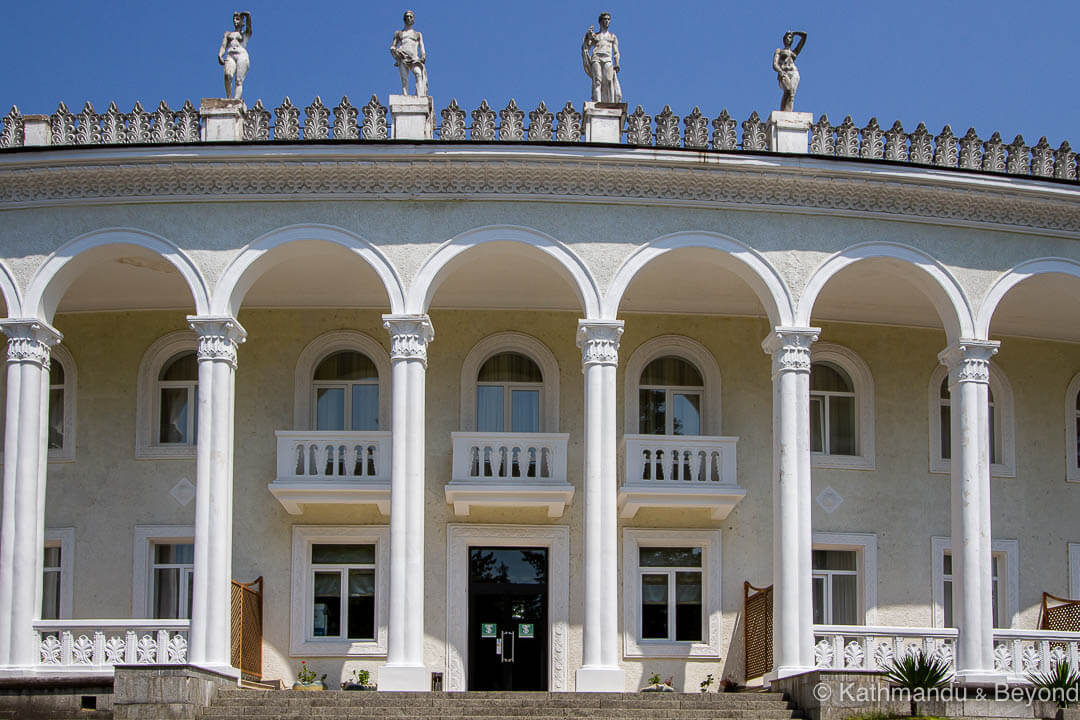
Things to see and do in Tskaltubo
Sanatoriums & Hotels
Sanatorium Shaxtiori
Shakhtiori, which translates as ‘Miners’ is one of the grandest and most renowned sanatoriums in Tskaltubo. A huge Stalinist-Empire style building dating from 1951, in its day the Shakhtiori would have been a prestigious place to stay. Ever since our first visit to Tskaltubo in 2018, the property, which belongs to a local millionaire, has been surrounded by metal fencing and protected by security guards. It is therefore technically off-limits. But, if you happen to catch the attention of the security guard and are prepared to play ball with any proposal he may put to you then there is the option to spend around 30 minutes looking around the building.
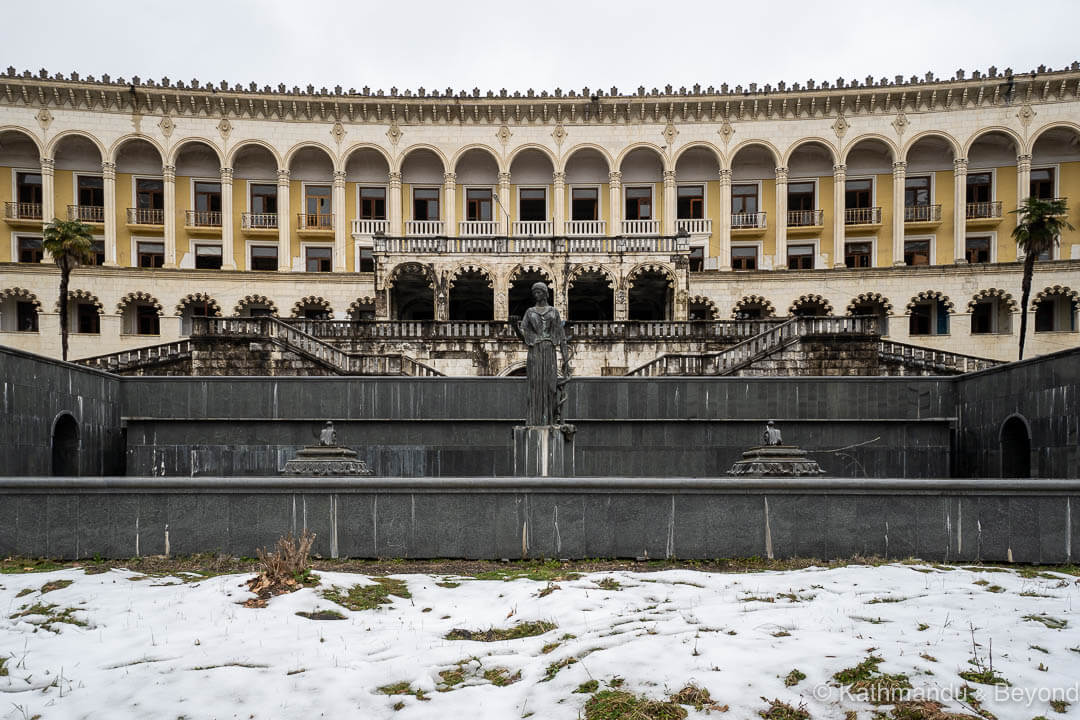
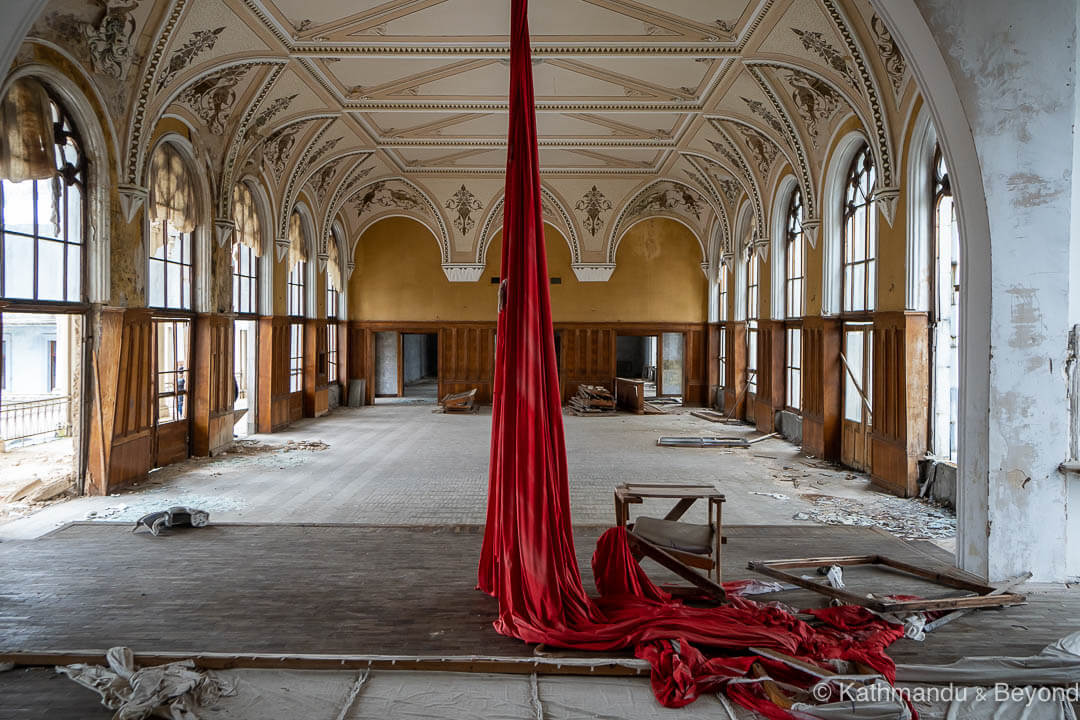
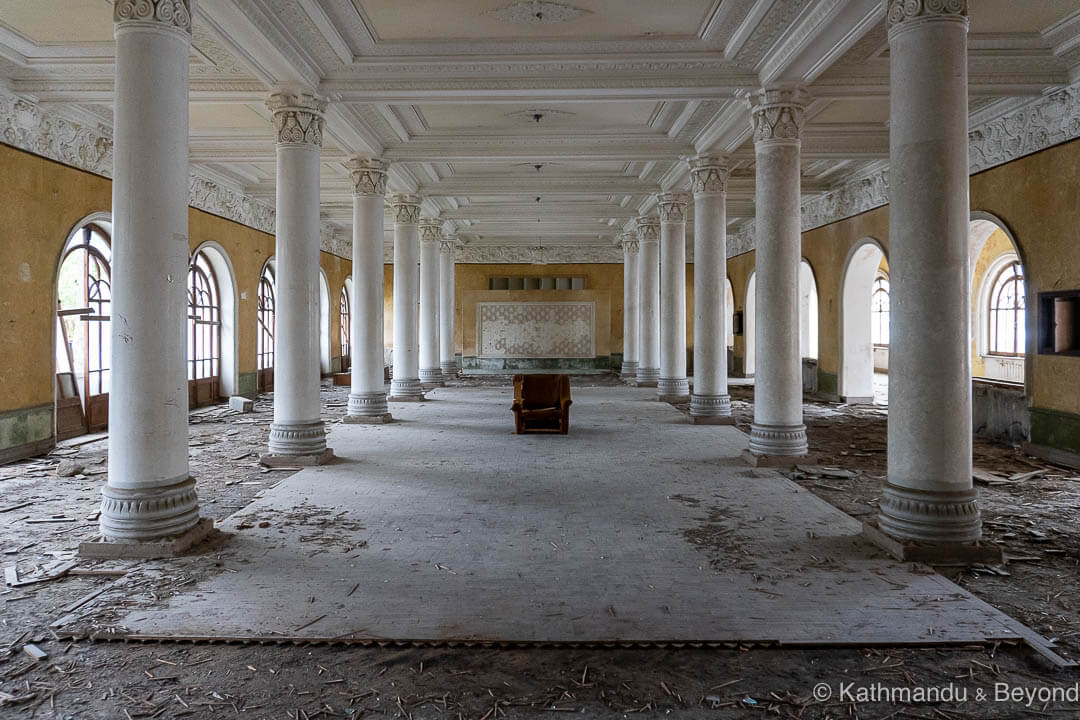
The plan is to return the Shakhtiori to its days of grandeur and reopen it as a luxury resort. Hence, the building is slowly being stripped in preparation for the revamp. That means there isn’t too much to see in most of the rooms of the Shakhtiori. The exception is the majestic ballroom along with one of the adjoining rooms where the decorated ceiling is still marvellously intact. We were told, by the security guard no less, that both Joseph Stalin and Lavrentiy Beria, one of his leading henchmen, danced in the ballroom on more than one occasion.
The other highlight of getting inside Shakhtiori is seeing the magnificent main entrance and getting an uninterrupted (i.e. no fence) view of the sanatorium’s sweeping facade.
Sanatorium Iveria
Sanatorium Iveria is also surrounded by a corrugated metal fence but the good news is that it is easy to squeeze through a section of it near the main gate. Plus, there is no security guard posted at this one.
Dating from 1962, Iveria is probably Tskaltubo’s most famous, and most-photographed sanatorium because this is where you will find the gaping circular hole in the ceiling; or floor depending on which level of the building you’re on (the first photo at the top of this post). A health and safety nightmare these days, the ‘hole’ was originally created as an internal balcony and became exposed after the surrounding balustrade collapsed at some point after the building stopped functioning as a sanatorium.
Crumbling stairs lead to the upper floors where guest rooms with peeling wallpaper and creeping ivy can be found, as well as a huge room with an ornate ceiling and tall arched windows which was presumably the dining hall.
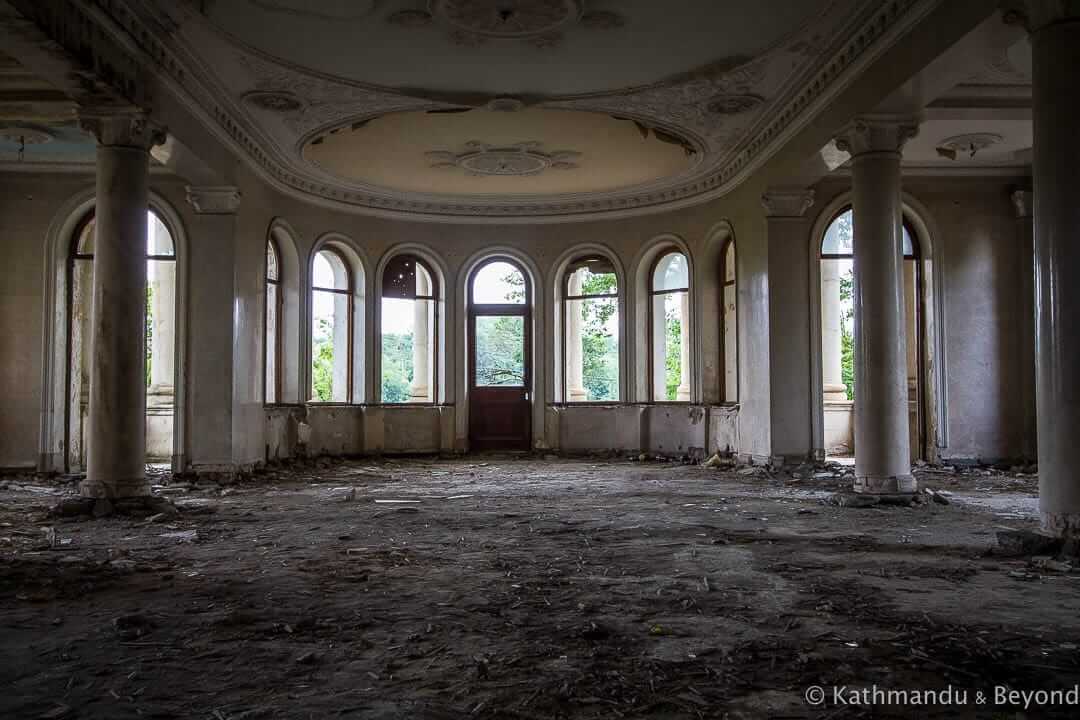
Compared with many of the abandoned buildings in Tskaltubo, the Iveria has retained some of its character. During one of our explorations of the place, we heard a sound and, always on guard in such places, listened intently. We soon realised it was kids chatting. There were clearly not paying so much attention to their surroundings as we were and we gave them the fright of their lives when they turned a corner and saw us! The young urbexers were two girls of about twelve years and (presumably) a younger brother. The woman at the tourist board told us she’d been in quite a few deserted sanatoriums when she was younger and it seemed to be a bit of a rite of passage for youngsters.
According to an online Georgian news site, the Iveria was sold to an investment group in 2017 for a little over US$100,000. Not a bad price, but there is a catch: the terms of sale stated that the buyer should invest at least €6 million in building a hotel with 160 rooms and employing 80 people. The terms, however, didn’t state that any original features must be retained, leading to the distinct possibility the building will be demolished rather than restored.
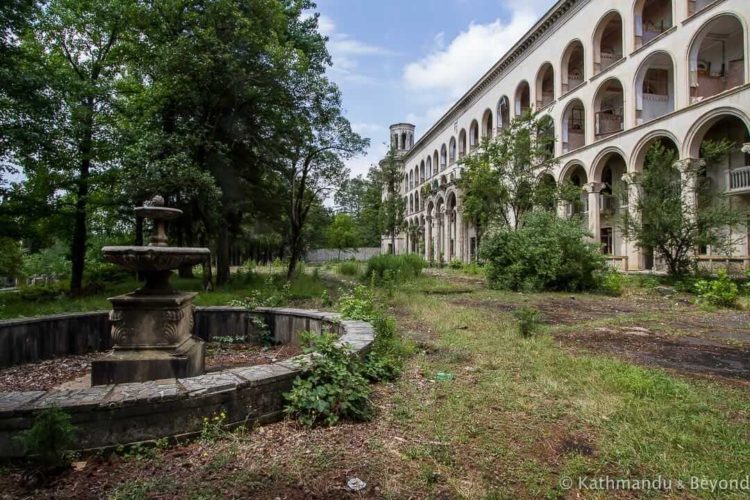
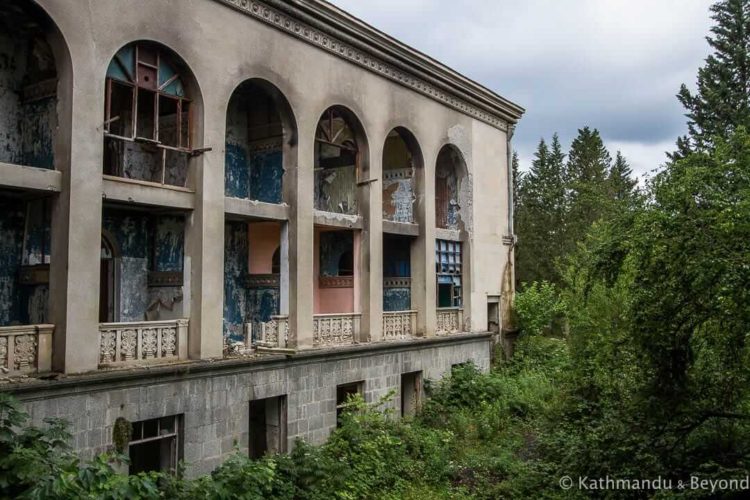
Hotel Savane
Located on the edge of the park, Hotel Savane is smaller in size and grandeur than both Shakhtiori and Iveria. It is completely abandoned and entry is unrestricted. The notable feature of the Savane is its semi-circular entrance. Savane was built for employees of the Minister of Defence of the Soviet Union.
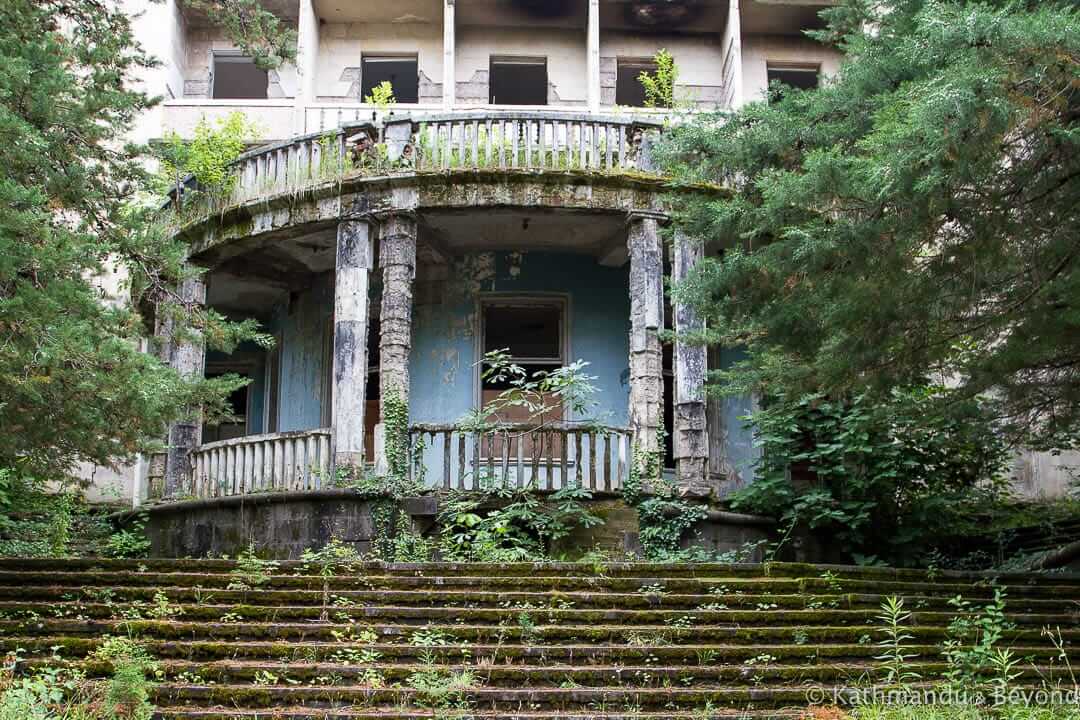
Hotel Savane (Medical Treatment Centre)
We were told locally that this building was a medical centre for the Hotel Savane. It is directly behind Savane so that information is probably correct. However, Google Maps lists the building as a Branch of the Research Institute of Resortology and when you begin to dig a little deeper, a couple of Georgian-language news sites list it as the former Sanatorium Filiali. Whatever its previous function, the property is partly inhabited by IDPs and part abandoned, mostly on the ground floor level. It is worth visiting for the impressive colonaded main entrance.
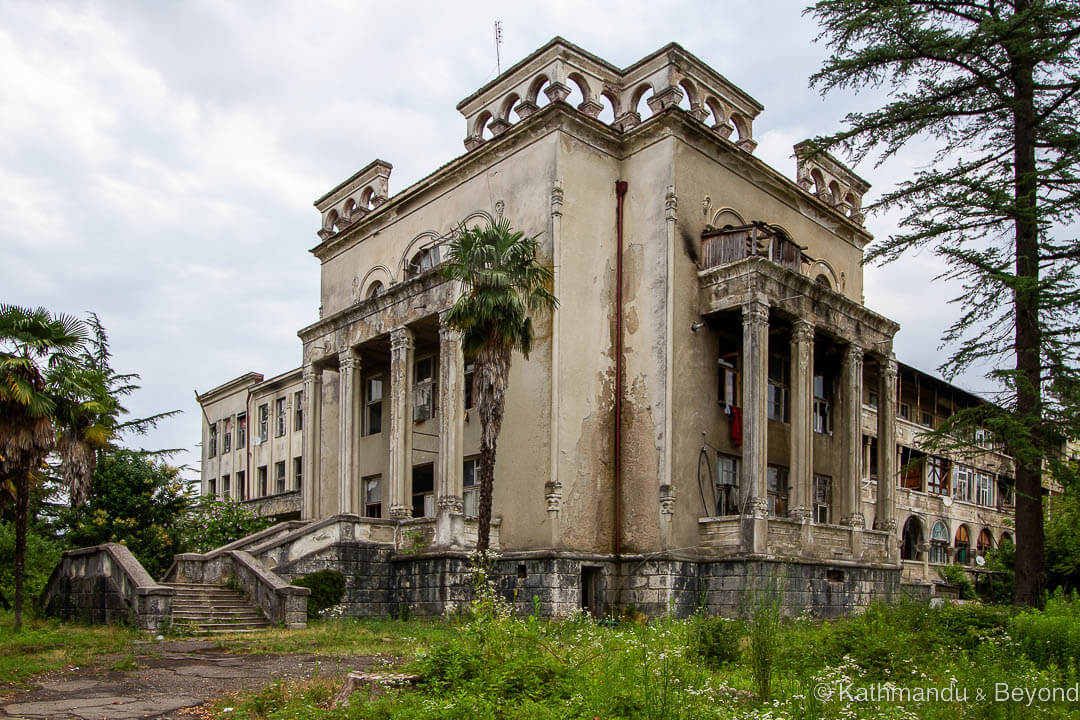
Sanatorium Tbilisi
Close to the centre of town and the bathhouses, the seven-storey Sanatorium Tbilisi originally belonged to the Ministry of Communications of the USSR. Dating from 1951, today it is one of a number of buildings in Tskaltubo that houses IDPs. Without intruding on people’s living quarters, the only part of the interior that can be visited is the inner courtyard which is neglected but atmospheric and covered with creeping lichen. The main entrance is guarded by two large griffins sculpted from stone.
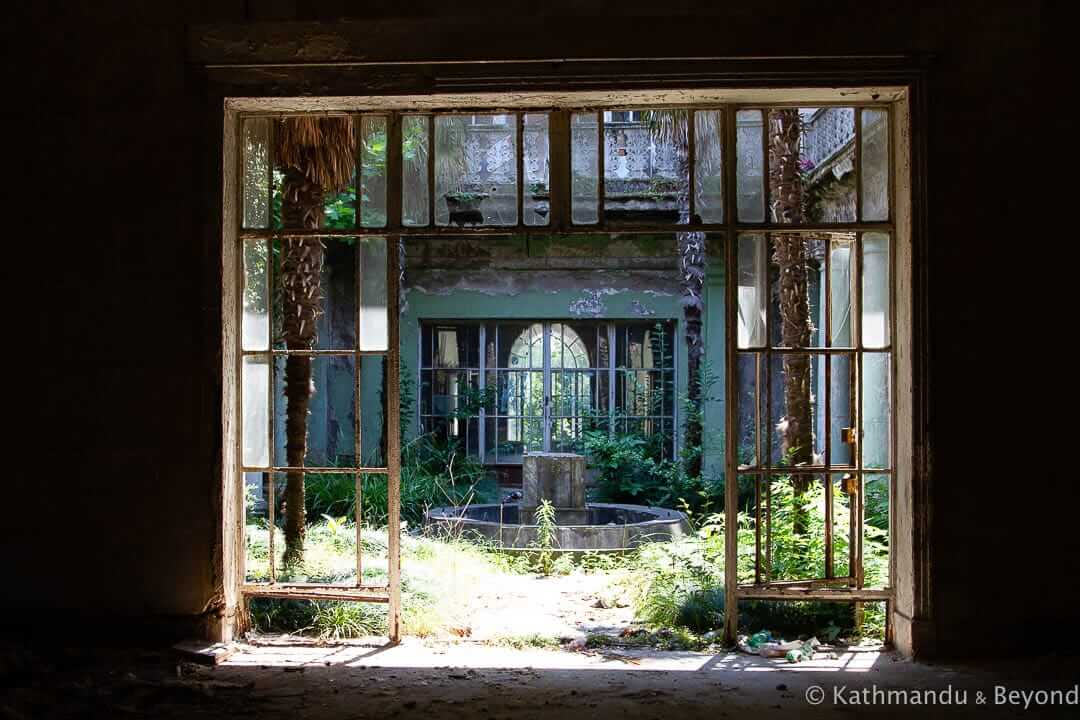
Sanatorium Geologist
Sanatorium Geologist is located between Tbilisi and Gelati (see next paragraph). It is more or less fully occupied by IDPs. Architecturally speaking, it is nondescript.
Hotel Gelati
Sanatorium Gelati is located 600 metres east of Hotel Tbilisi. It is a large property that is divided into two parts. The west wing and the rooms surrounding the central courtyard are occupied by IDPs, whereas the east wing is completely abandoned. Behind the sanatorium are (probably) the remains of a children’s play area/paddling pool that is decorated with a Soviet-era mosaic. The area is fenced off and used to house livestock. Annoyingly, it is also guarded by an aggressive dog who is on a chain but still an effective deterrent to stop anyone from getting too close.
There is also a small abandoned building close by the sanatorium which possibly was part of the original complex.
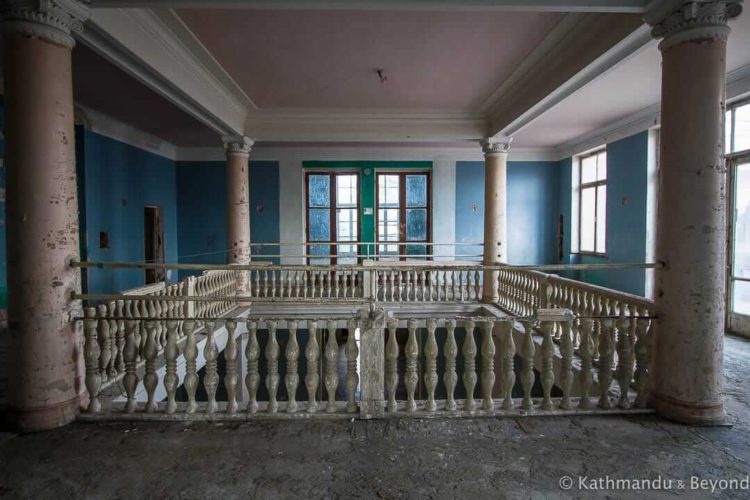
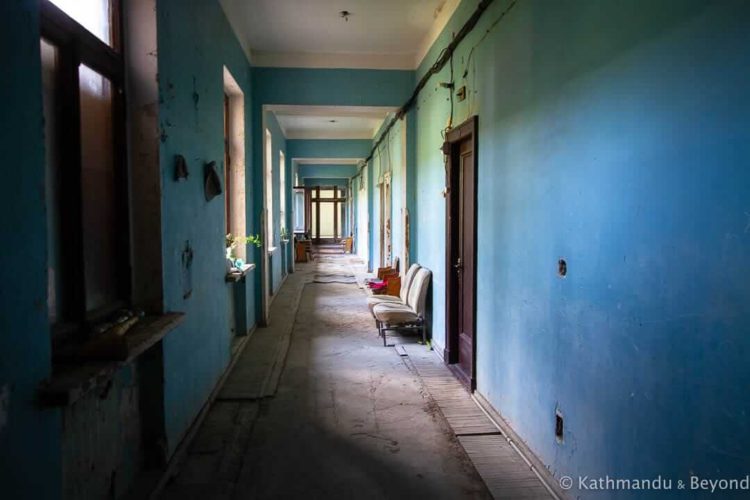
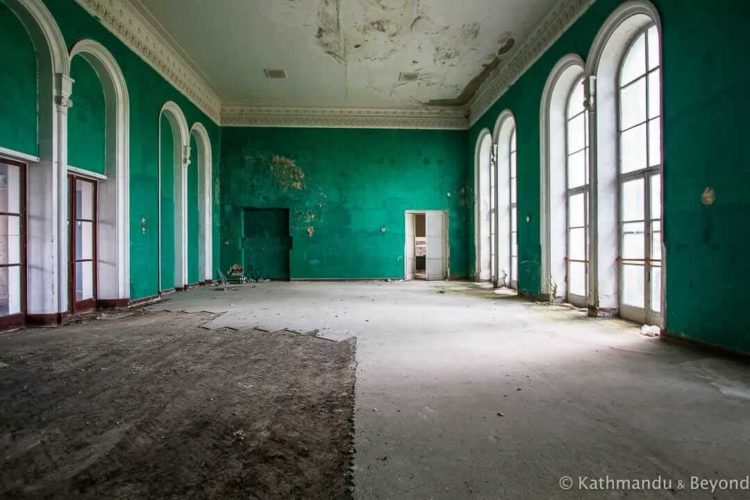
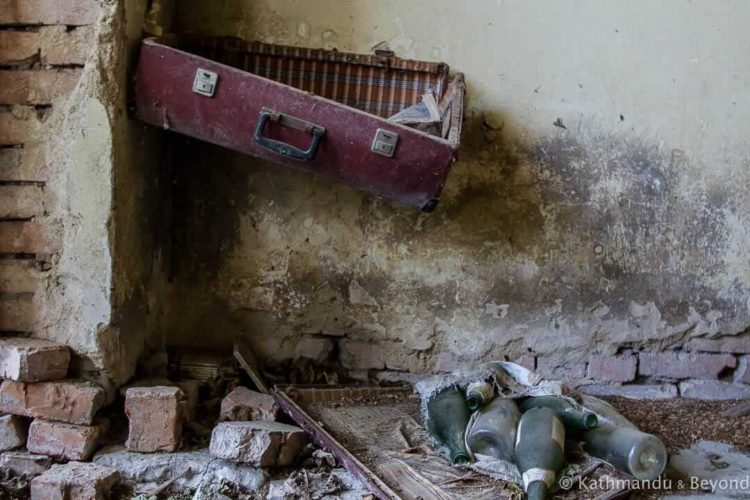
Sanatorium Megobroba (Friendship) II
There are two parts to Sanatorium Megobroba. Both buildings are identically shaped and are linked via a walkway. In the middle of the walkway is the remains of what presumably used to be the main dining room. We would like to have explored this one in more detail but the snow was very deep during our visit and access to the outer areas was tricky.
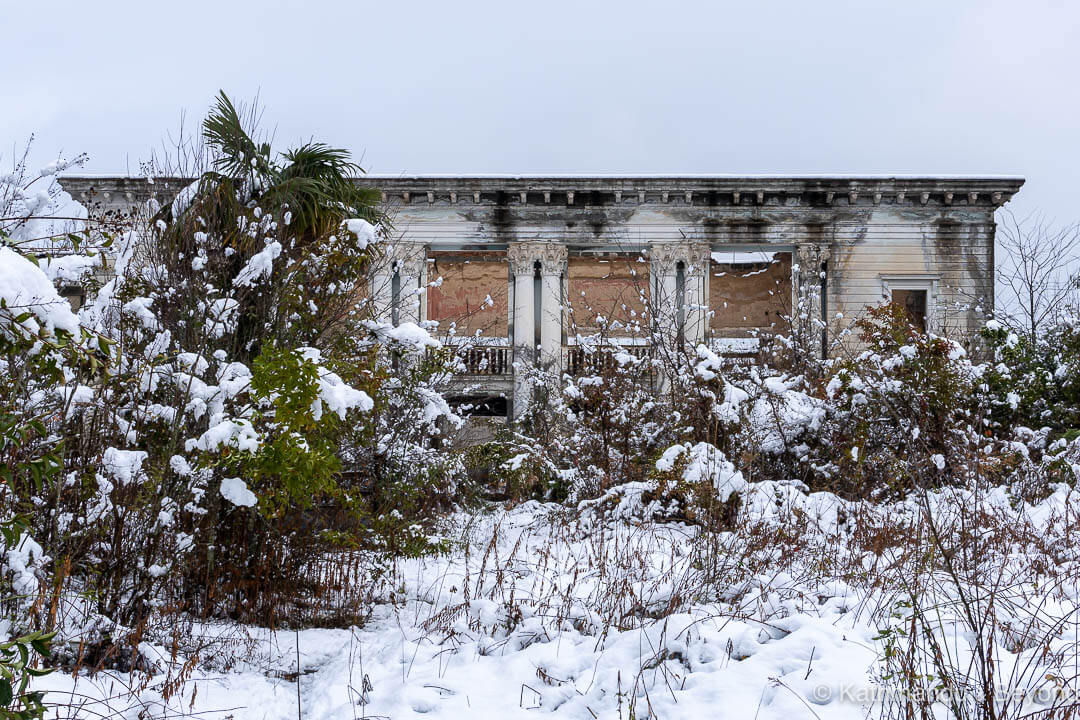
Hotel Medea
Approaching Sanatorium Medea via its long driveway is likely to spark a ‘whoa, check that out!’ moment when you first clapped eyes on the property’s impressive collonaded facade. Much of Medea is living quarters for IDPs (we asked a family sitting on a nearby bench if it was OK to take a look around and “you are most welcome,” was the father’s response and he pointed in the direction we should head) but the section beyond the plethora of marble colonnades and arches is free to explore. An exposed stairway to the right of the entrance leads all the way to the roof from where there are great views of the sanatorium’s inner courtyard. It is acceptable to also explore the courtyard but, on both occasions we have tried, it has been very overgrown and therefore difficult to navigate.
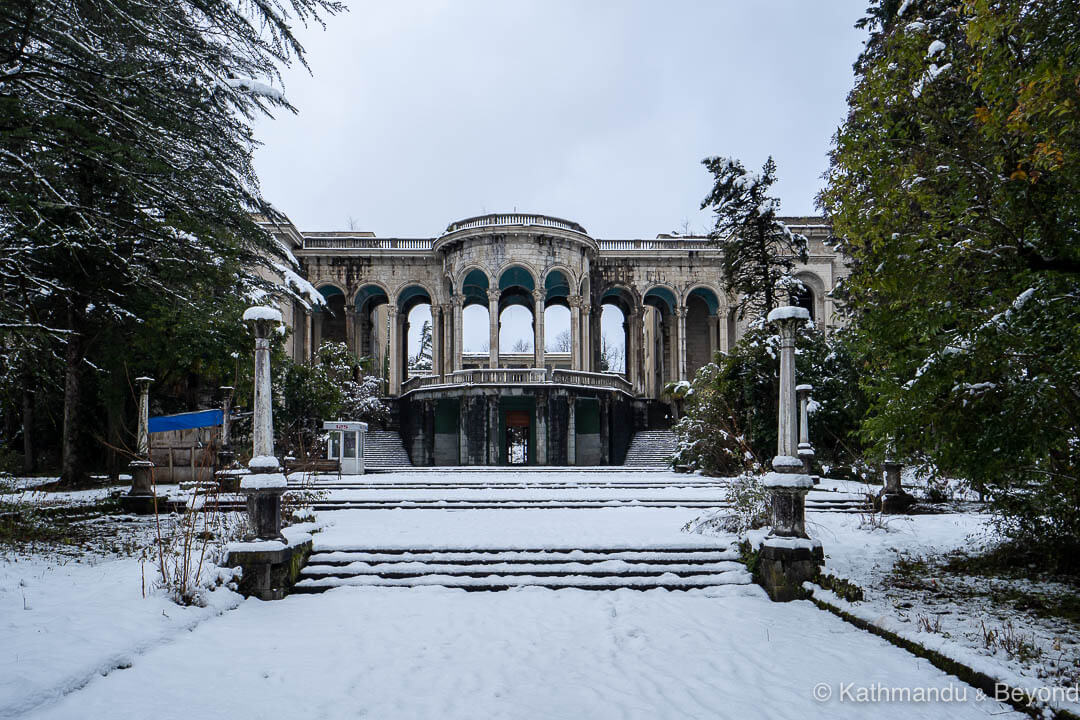
Sanatorium Tskaltubo and Sanatorium Rkinigzeli
Next to each other, these two properties are positioned between Medea and Metalurgi. As it was snowing heavily and we were frozen to the core by the time we got to these two, we decided to leave them for another time and have a reason to return to Tskaltubo for the umpteenth time!
Sanatorium Metalurgi
Metalurgi is one of the most interesting sanatoriums to visit in Tskaltubo. The exterior of the building, which is classic Stalin-Empire style, is noteworthy but it’s the atmospheric public areas inside the sanatorium itself, as well as the large theatre/ballroom at the back of the building that are the definite highlights.
With large internal balconies and huge chandeliers hanging from the ceiling, Metalurgi is the easiest of Tskaltubo’s sanatoriums in which to conjure images of what the town would have been like at the height of its popularity.
The large theatre/ballroom, or whatever it used to be, was padlocked during our first visit to Tskaltubo in 2018 and we had to be content with peering in via some mashed windows. There was still quite a bit of the original furniture in the room back then. Fast forwarding to 2022 and our last time at Metalurgi, the space was wide open but had been cleared of most of its furnishings. A high percentage of Metalurgi is occupied by IDPs.
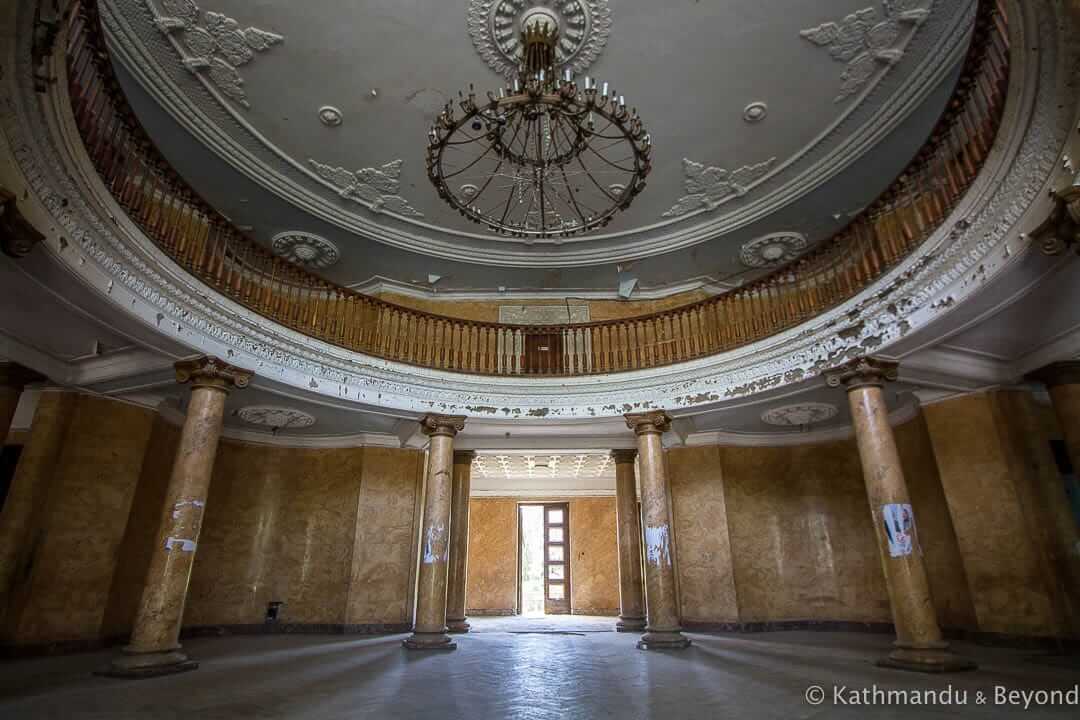
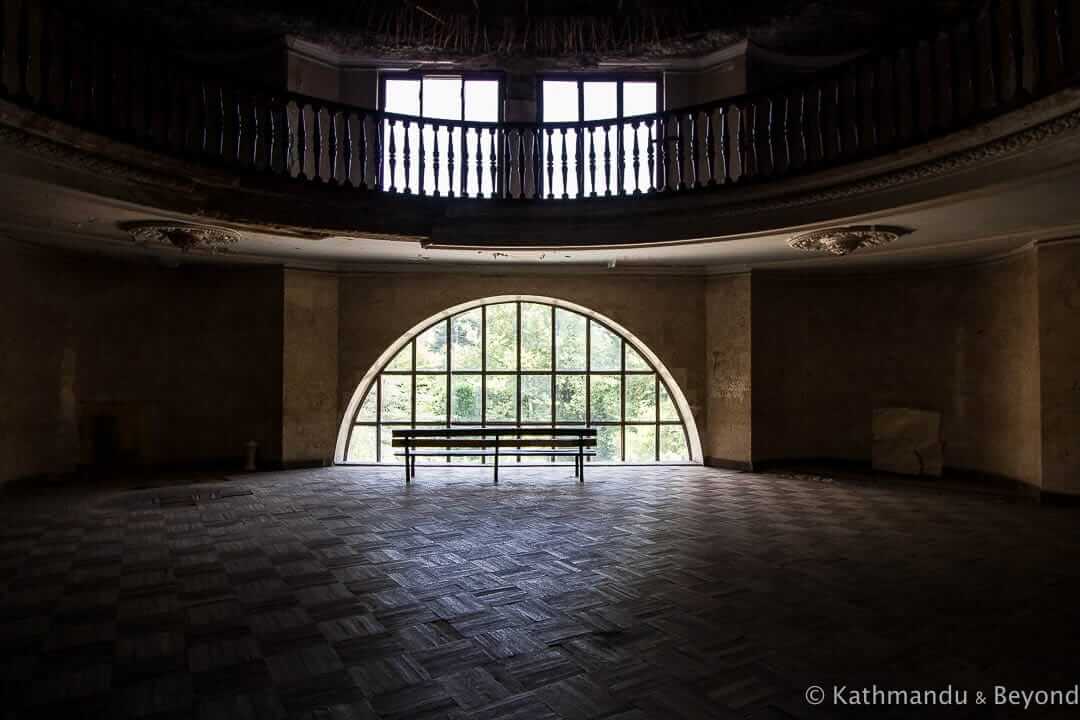
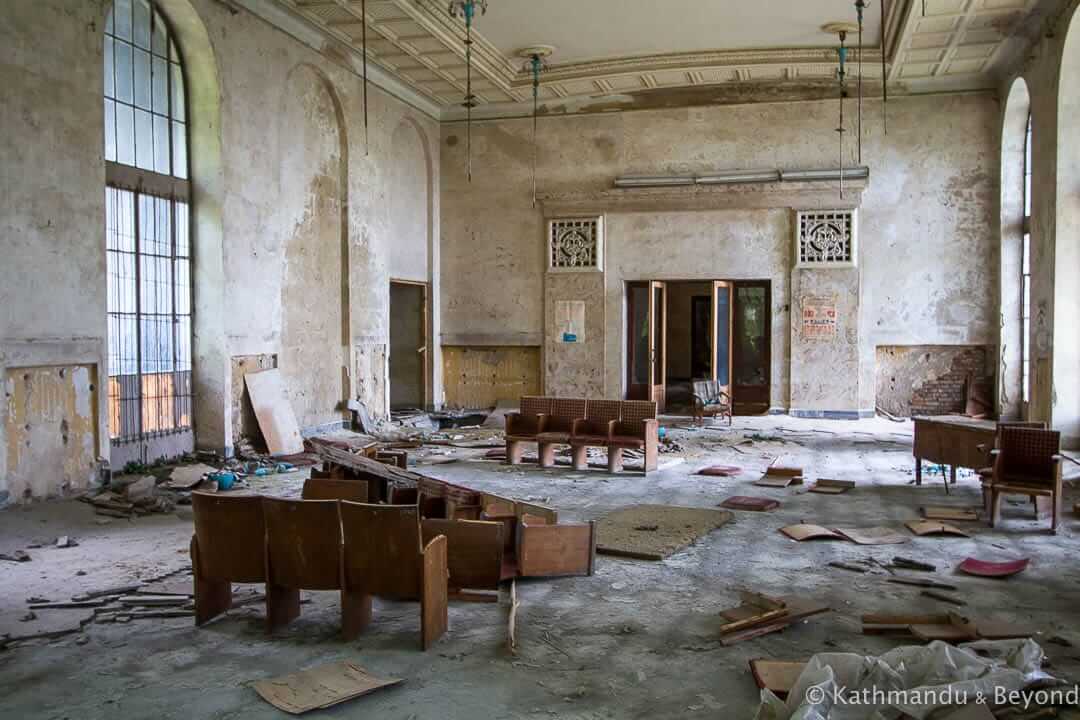
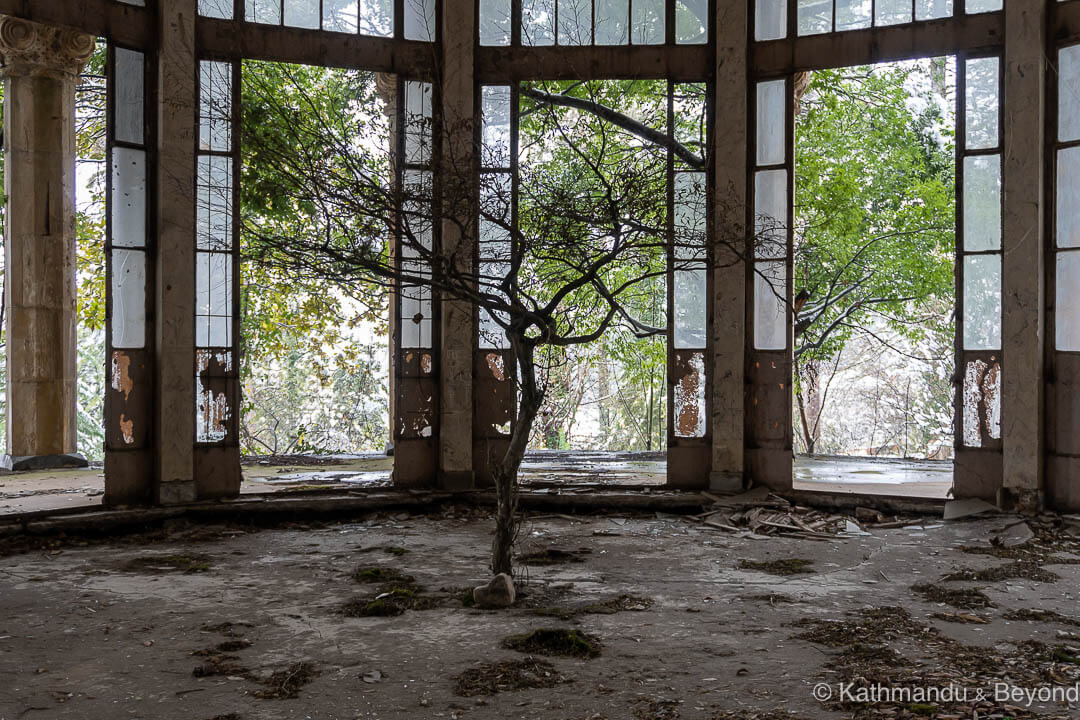
Hotel Sakartvelo
This hulk of a building, which was constructed in Soviet Modernism style between 1974 and 1983, is easily visible on the drive into town from Kutaisi. At an estimate, at least 60% of it (mostly the upper floors) houses IDPs while the rest is derelict and in many parts dripping with water (the temperate climate with high rainfall and humidity may be conducive to water therapy but it’s not so kind to ageing buildings). The main thing to see is the mosaic-covered indoor swimming pool. The pool is in a sorry state but the mosaic itself is reasonably intact in places.
There are more people in and around Sakartvelo going about their daily business than in any other sanatoriums in Tskaltubo so the scene can feel voyeuristic at times.
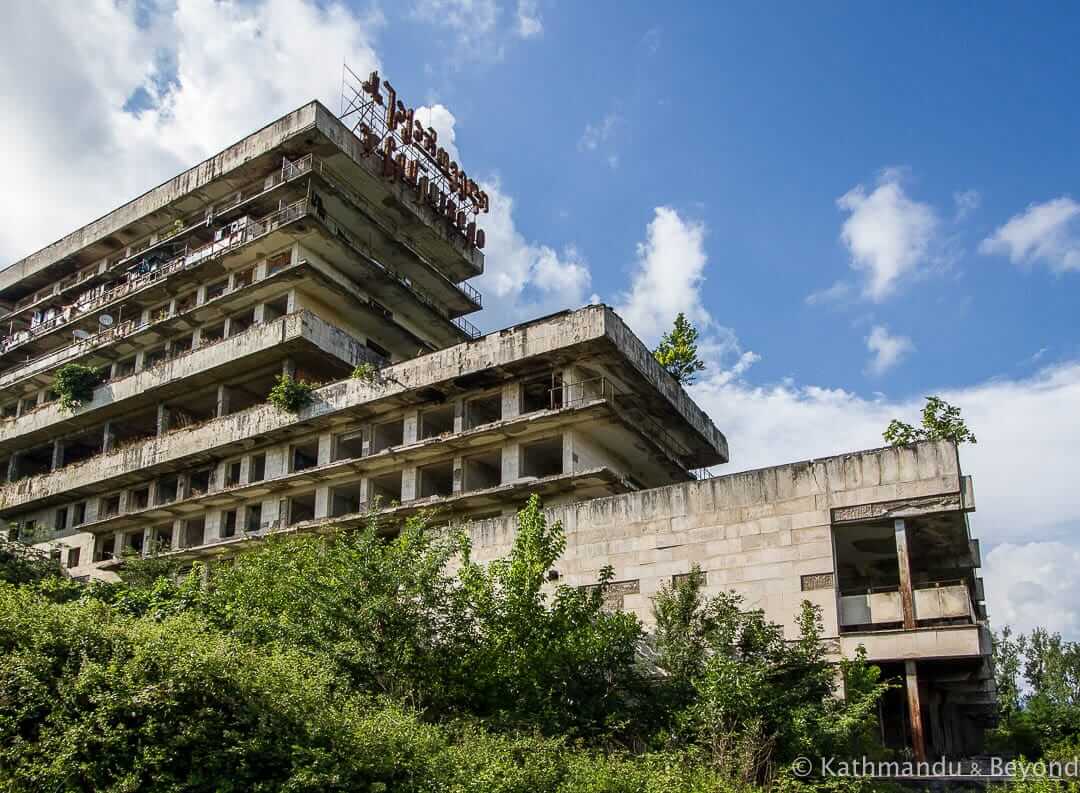
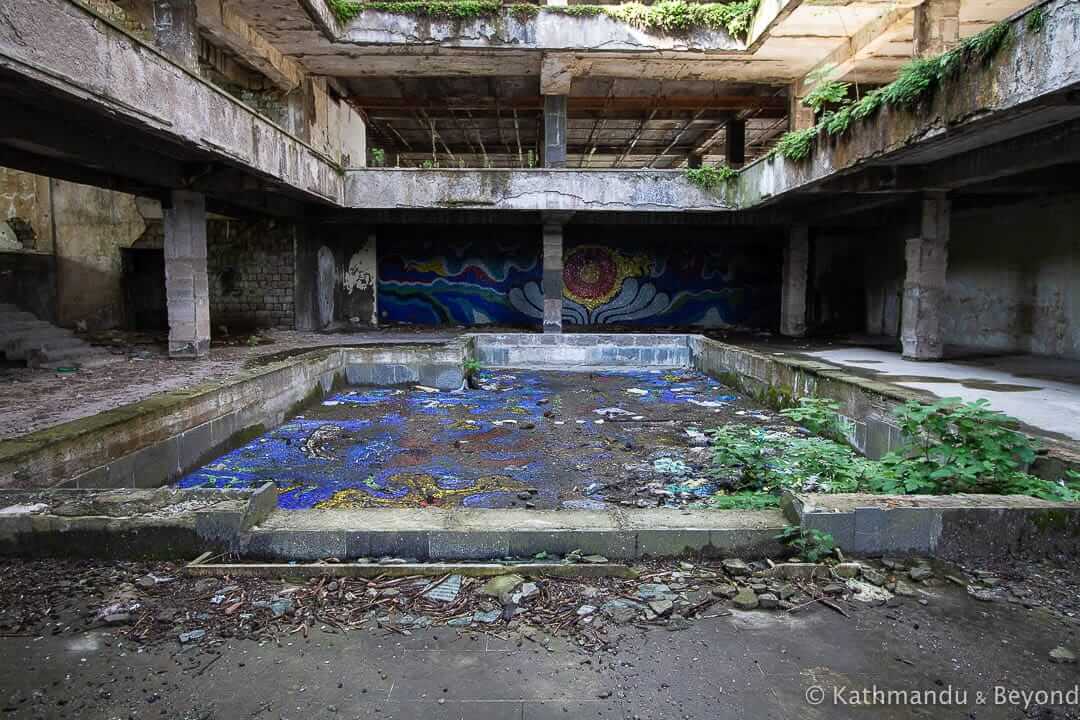
Hotel Intourist
We didn’t venture inside this one and only viewed it from the outside. While there, we got talking to a guy who was playing football with his daughter in front of the hotel. He told us he had lived there for twenty-five years as an IDP; since he was a small boy in fact, and that he could never return to Abkhazia. Practically all of the building was occupied and that was the main reason why we didn’t enter. For the best view of the Hotel Intourist, stand in front of Hotel Sakartvelo.
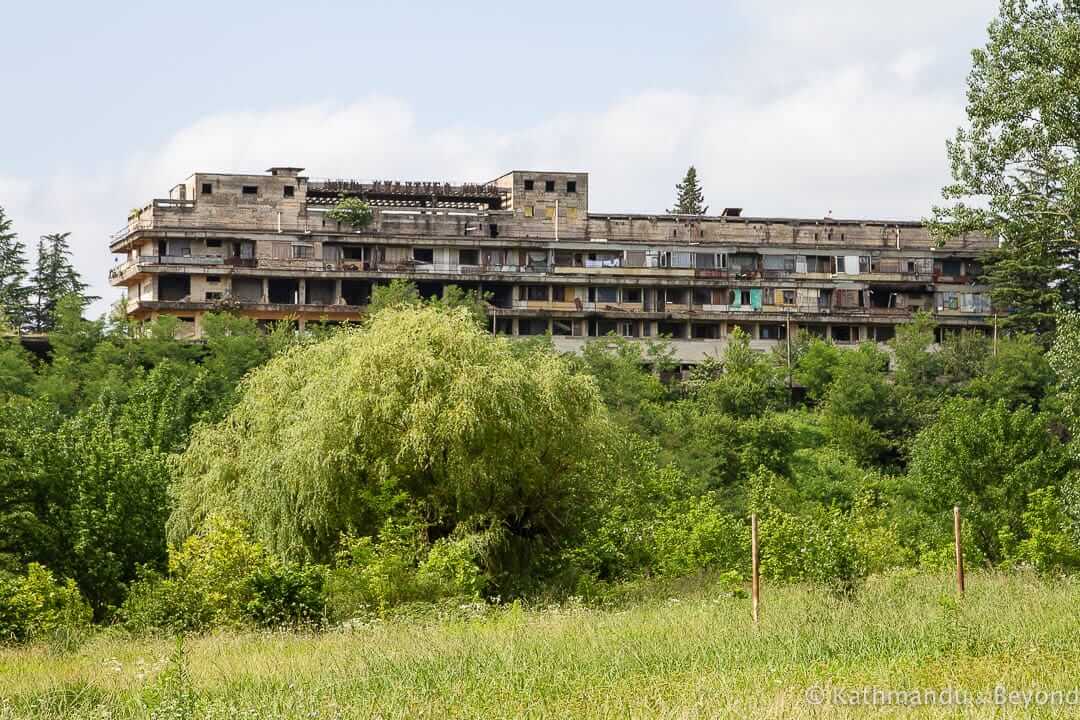
Tskaltubo Spa Resort
The Tskaltubo Spa Resort was built in the 1950s in Stalin-Empire style and was originally named the Military Sanatorium of the USSR. Only employees of the Soviet Ministry of Defence, and their families could stay there.
The Tskaltubo Spa Resort is the only original sanatorium currently in use, having reopened in 2011 after an extensive renovation of two of the three grand buildings. The renovated part of the resort has been wonderfully restored but it is the untouched wing that is the main draw. Like stepping back in a time warp, it is in this section of the property that you will find period furniture, Norman Bates-Esque corridors, overgrown courtyards and all manner of relics from 1950s Soviet Union. Furthermore, Stalin had a private suite at the resort and, rather like a museum piece, the room was made up to such a high level when we saw it that it was as if the staff were expecting the man himself to arrive at any moment.
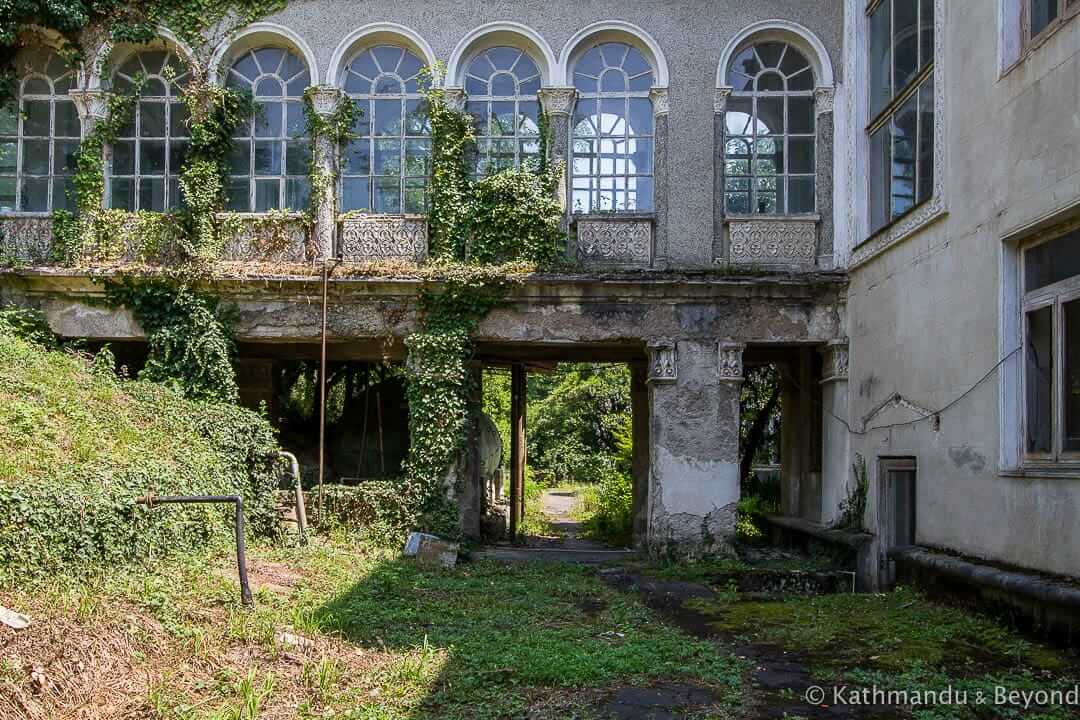
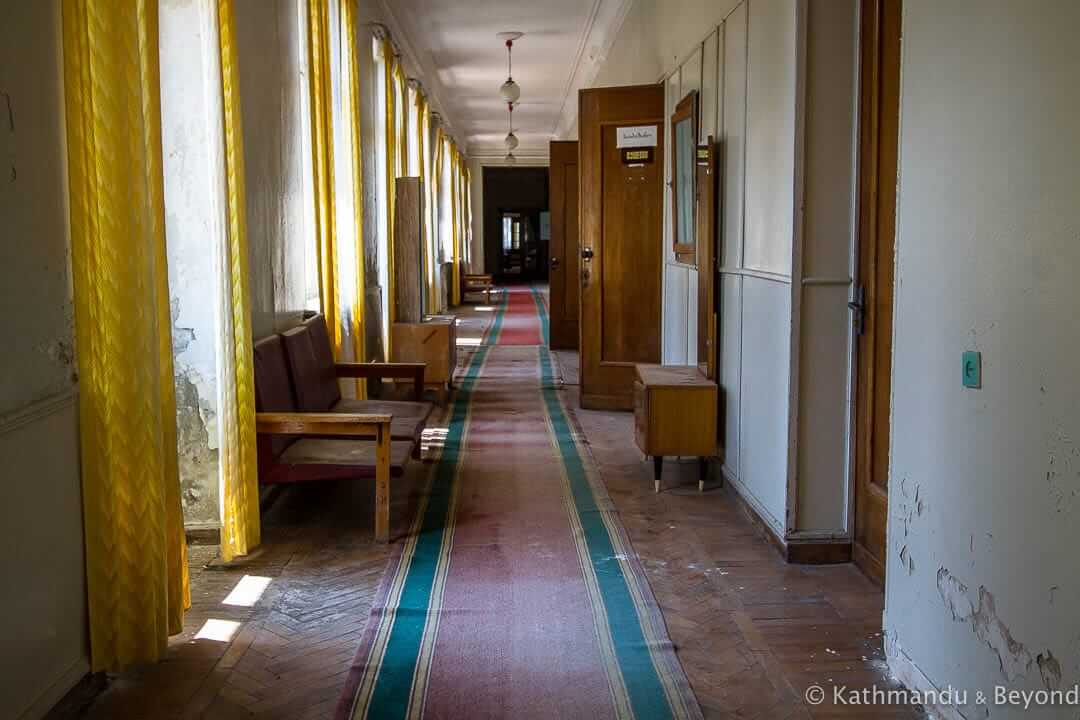
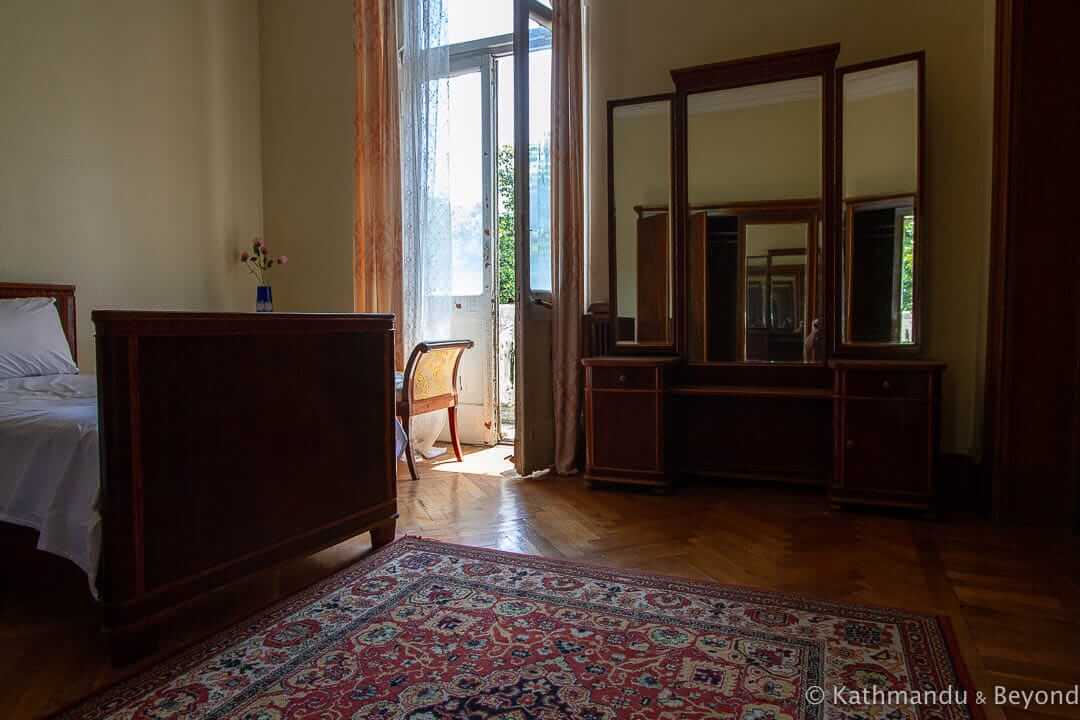
During our first visit to Tskaltubo in 2018, we were lucky in that, although we weren’t staying at the resort, we asked at reception if we could look around the property and they not only obliged but sent one of the staff with us to show us around. With more people visiting Tskaltubo and learning about the existence of the non-renovated wing of the property (hopefully via this blog!) this is no longer an option. There is now a security guard at the main entrance who vets visitors on arrival. The only guaranteed way to gain access and see sections of the building described above these days is to spend the night at the resort.
Sanatorium Imereti
With its sweeping staircases, marble columns and the remains of a majestic rotunda, Sanatorium Imereti is another of Tskaltubo’s highlights. Imereti is big and it takes a while to explore it fully. We saw possessions in some of the corridors in the right wing of the property that would suggest that this part of the building is occupied by IDPs. But, we didn’t see anyone so can’t confirm this for certain. Mind you, it was snowing heavily and freezing cold when we visited Imereti so maybe any occupants were, very sensibly, staying inside their homes and keeping warm!
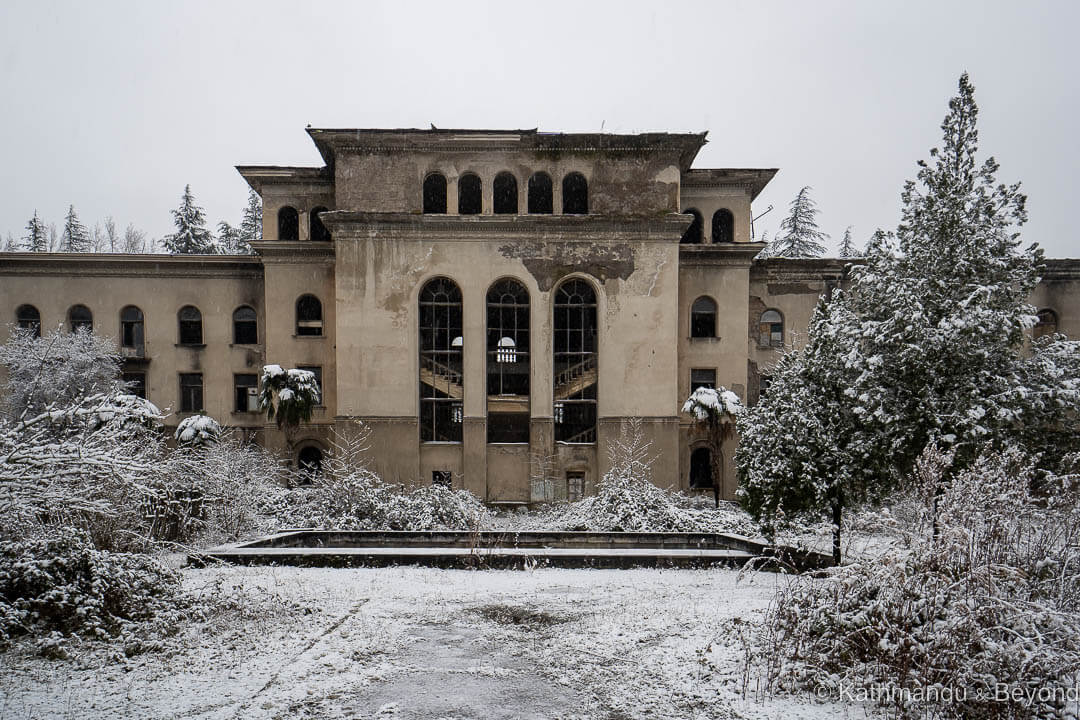
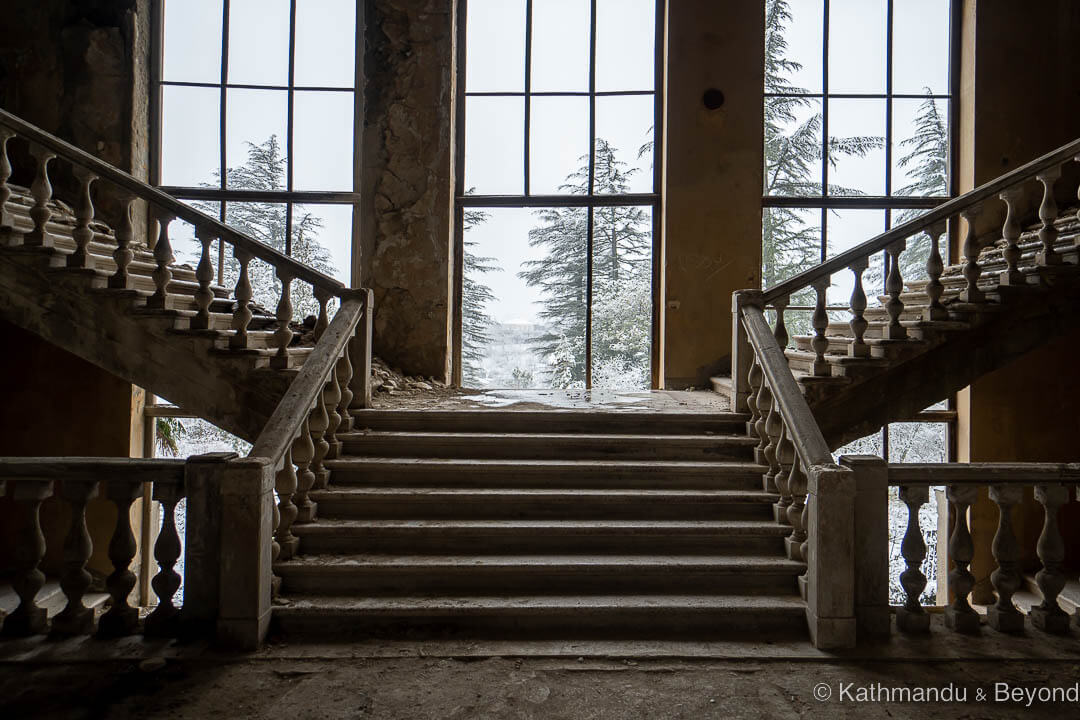
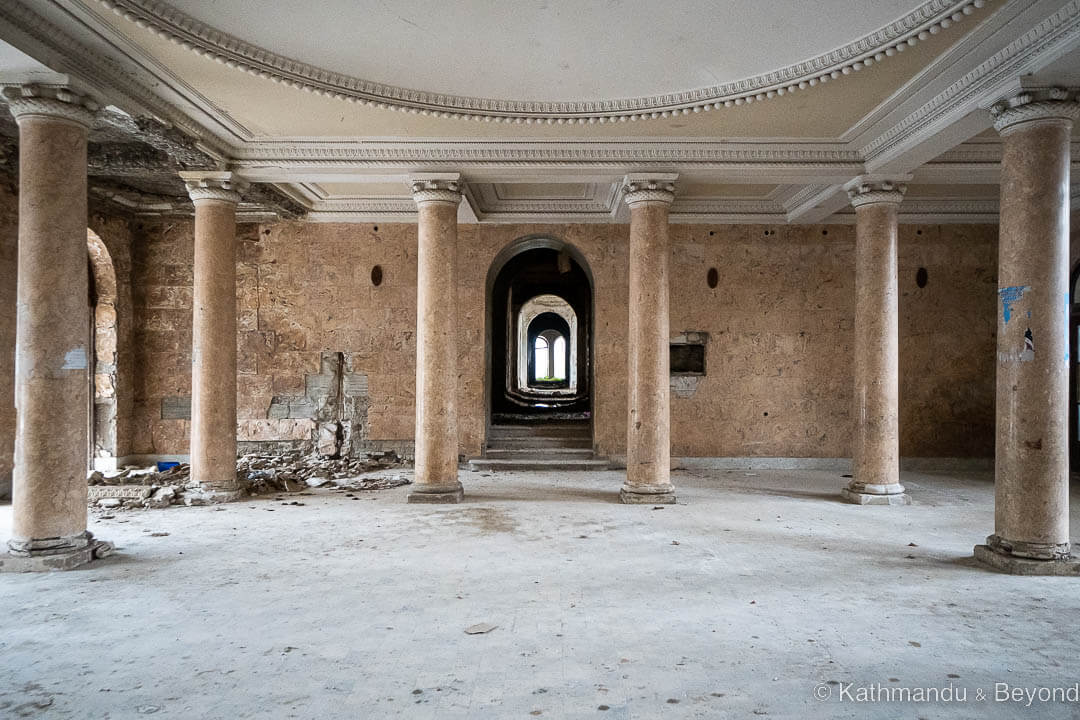
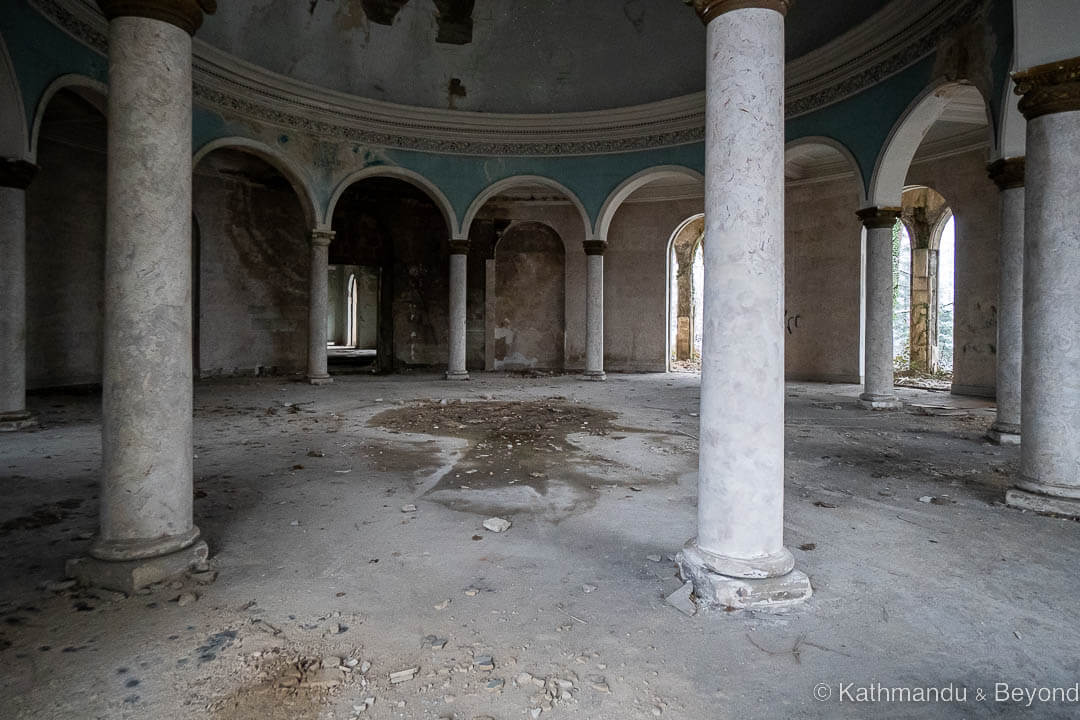
Hotel Sinatle
Hotel Sinatle is next door to Imereti. The small, metal-roofed building is fully occupied by IDPs and we didn’t venture beyond the lobby area.
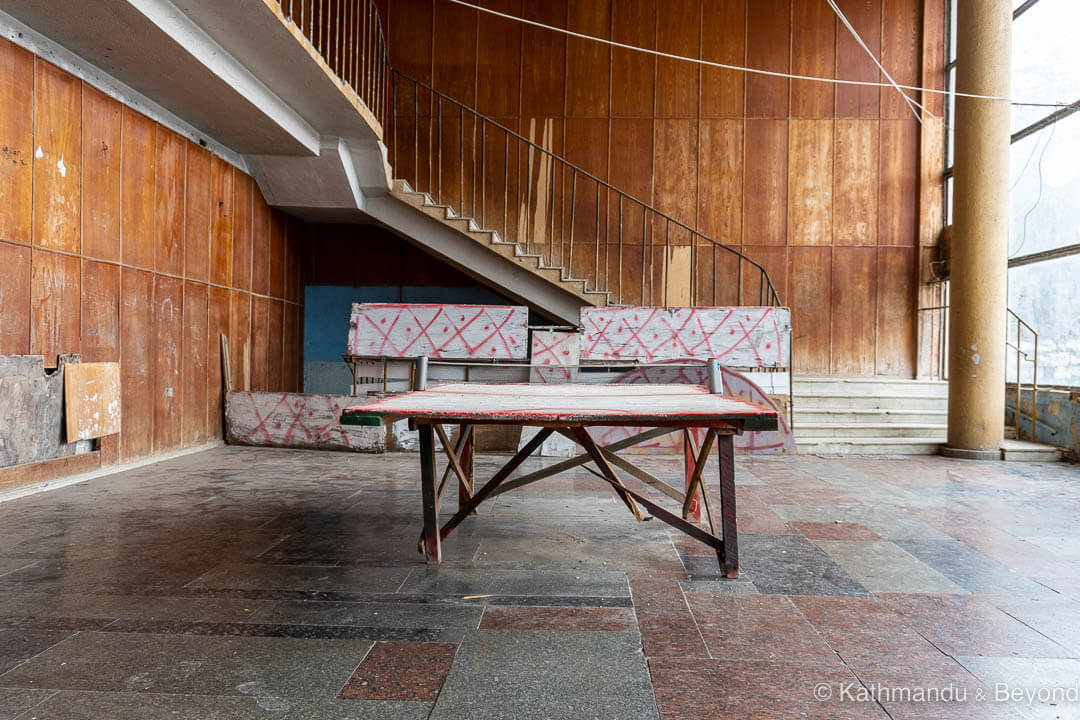
Hotel Samgurali
Several storeys high, Hotel Samgurali is located up the hill from Savane and across the road from Imereti. Closer inspection of the building’s exterior highlights the hardship that probably all IDPs in Tskaltubo have to endure. Many of the residents in Hotel Samgurali have enclosed their balconies to give themselves more internal space. The property dates from 1974.
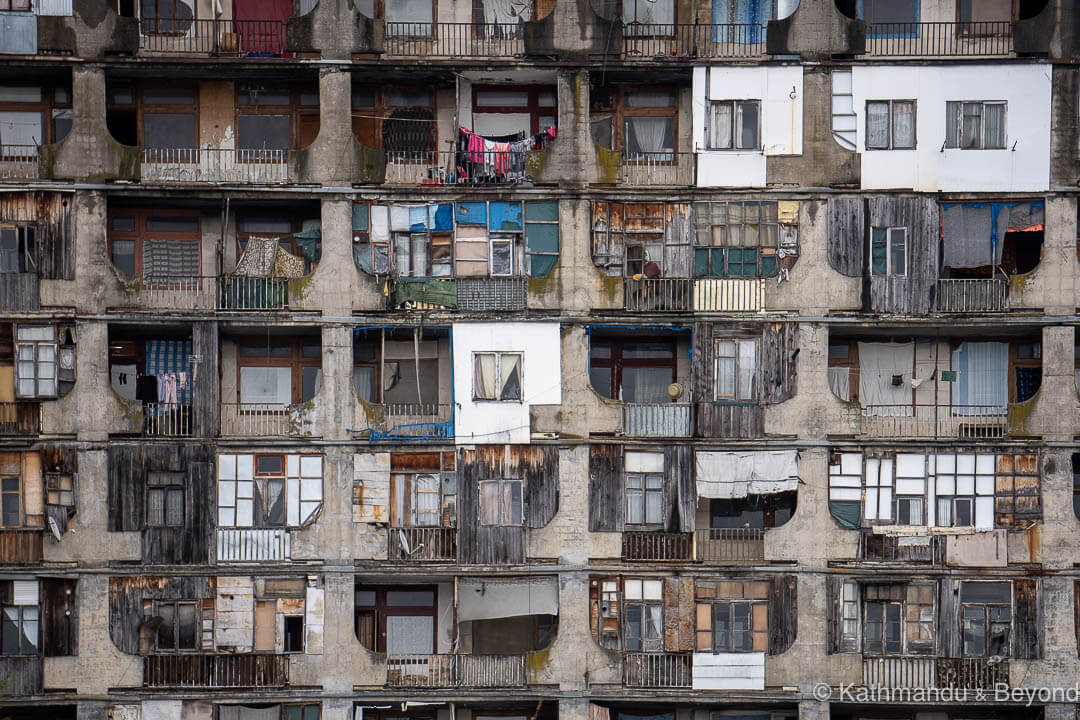
Hotel Aia
Constructed in the 1970s through to the 1980s for the Ministry of Internal Affairs of Soviet Georgia, Aia, sometimes spelt Aya, is another example of Soviet Modernism. The six-storey building is also almost fully occupied by IDPs. Two large pieces of mosaic panel art are the main feature here. The one on the outside of the property is not in great condition, but the wine-themed mosaic inside what used to be the main restaurant is in great condition, which is a surprise considering that the now-derelict space is damp and neglected.
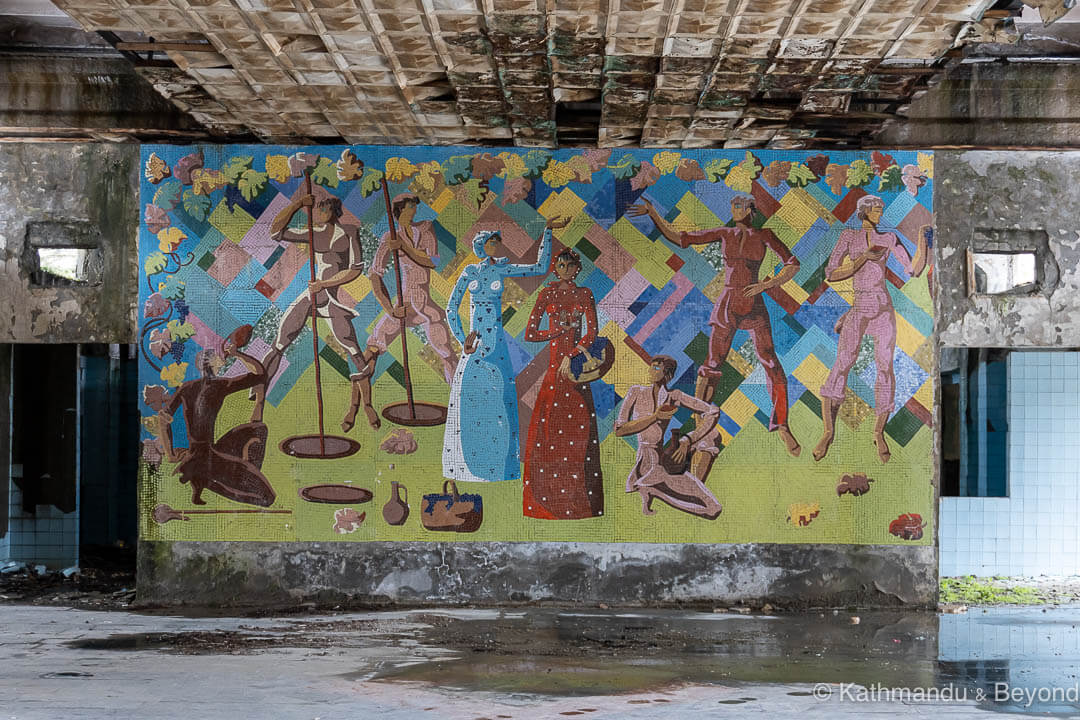
Bathhouses & Spas in Tskaltubo
Tskaltubo had nine imaginatively-named bathhouses or ‘springs’, located in the central park and consisting of thermal baths and treatment rooms. The healing properties of the water in Tskaltubo claim to cure some sixty diseases. Of the nine buildings, we believe four are currently in use: Bathhouses Number 1, 2, 3, and 6. As part of Tskaltubo’s regeneration plan, the hope is that all of the bathhouses will eventually be renovated and put back into full use.
Bathhouse Number 6
Sometimes referred to as ‘Stalin’s Bathhouse’, this is Tskaltubo’s main bathhouse and is situated directly on the mineral source. It’s still in use and well-maintained. The facade is classic Stalinist Empire style, which is lucky given this wellness centre was a particular favourite of the ‘Boss’, and specially built for the man himself. He had his own private pools featuring ornate mosaic work and the reception staff were quite happy to show it to us when we asked. This was 2018 and, as with our experience at the Tskaltubo Spa Resort (see above), the attitude of the employees, and restraints on their time, are not the same these days. Hence, there is no guarantee if you ask to see Stalin’s private bath whether you will be allowed or not, particularly as a member of staff has to escort you there and back from the main reception area.
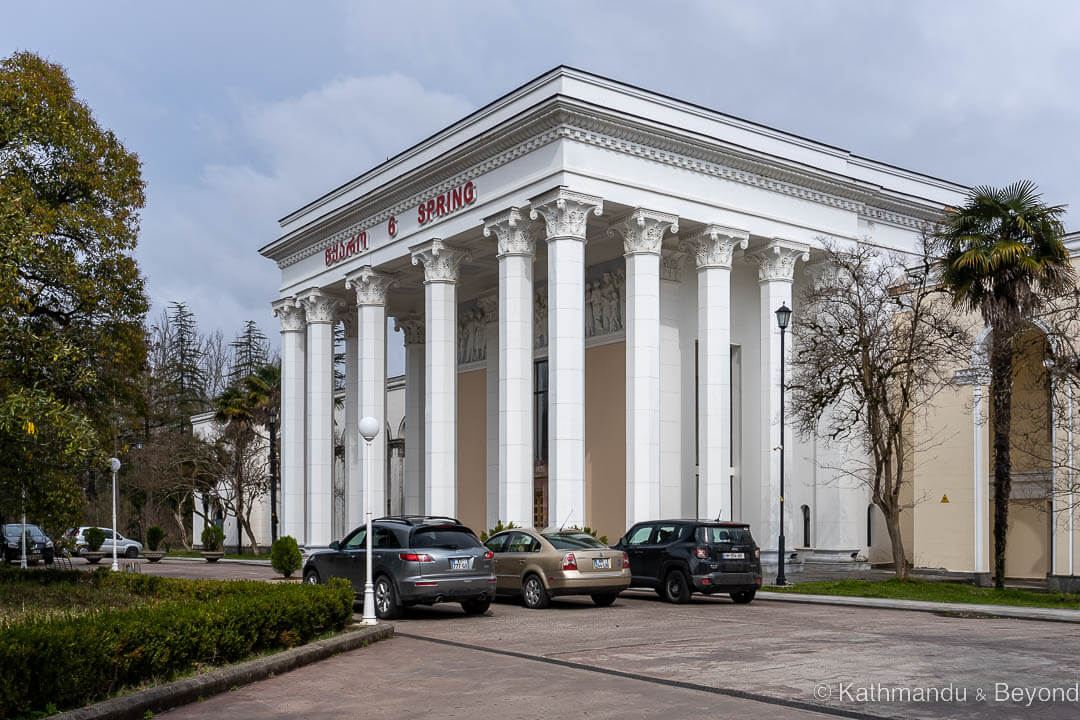
Regardless, it is still worth heading to Bathhouse Number 6 to see both the impressive facade (note the sculpted relief above the door featuring Stalin greeting bathhouse visitors) as well as the grand entrance hall, where the centrepiece is a huge urn displaying images of Tskaltubo’s sanatoriums in their glory days.
Rumour has it there are plans to renovate Stalin’s personal pool and open it up for public use. We assume this hasn’t yet transpired but the entrance hall looked like it had been renovated since our first visit in 2018 so it may well happen at some point in the future.
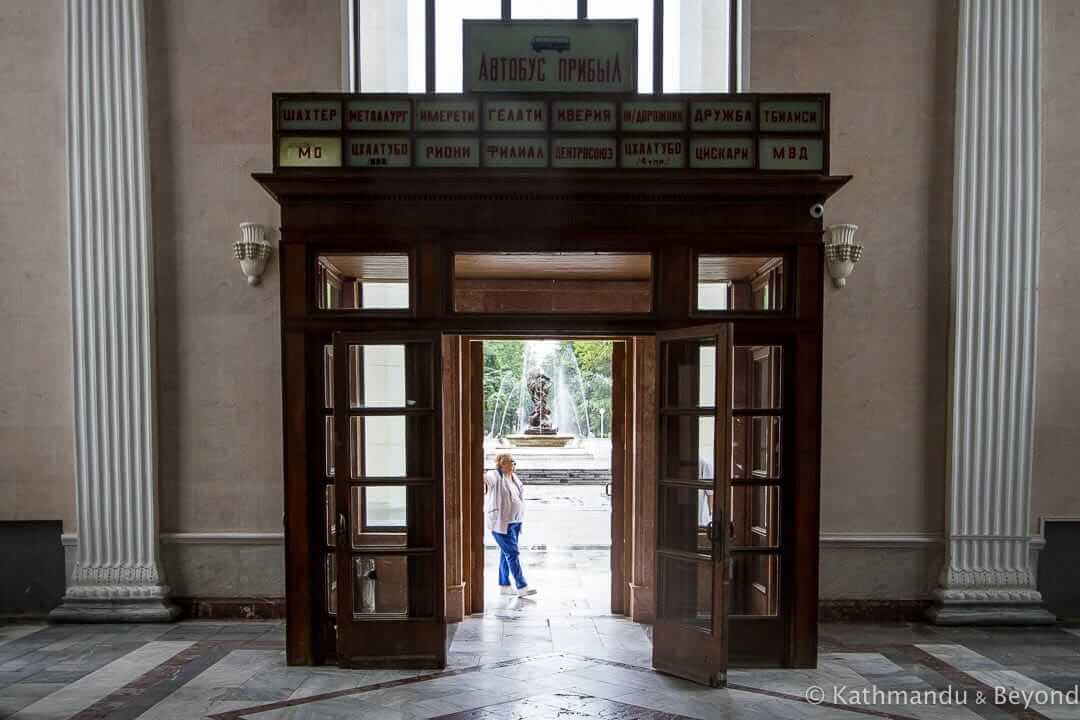
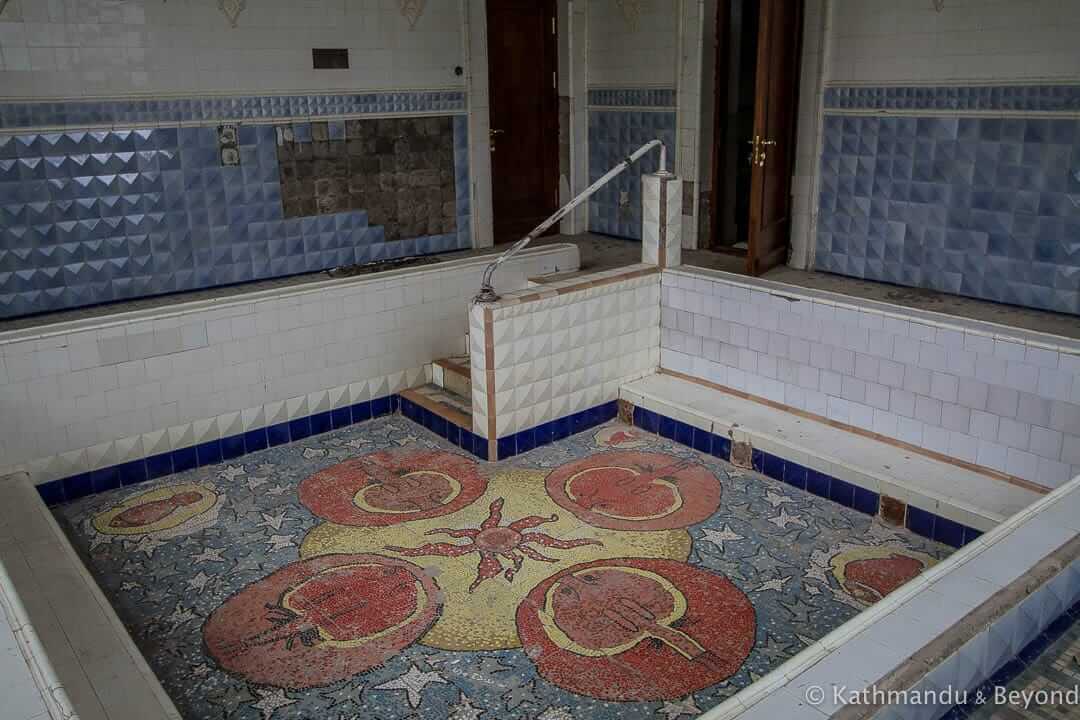
Bathhouse Number 8
A short distance from Bathhouse Number 6, Number 8 is a communal bathhouse that was presumably more for the proletariat rather than the party elite. It is completely abandoned and given over to the elements and the huge, central skylight (which may have been covered originally) gives it a UFO feel.
Bathhouse Number 8 is in an appalling condition but it is still possible to make out the relief depicting woodland scenes, including Bambi-like baby deer, that decorate the low walls that divide one set of bathing pools from another.
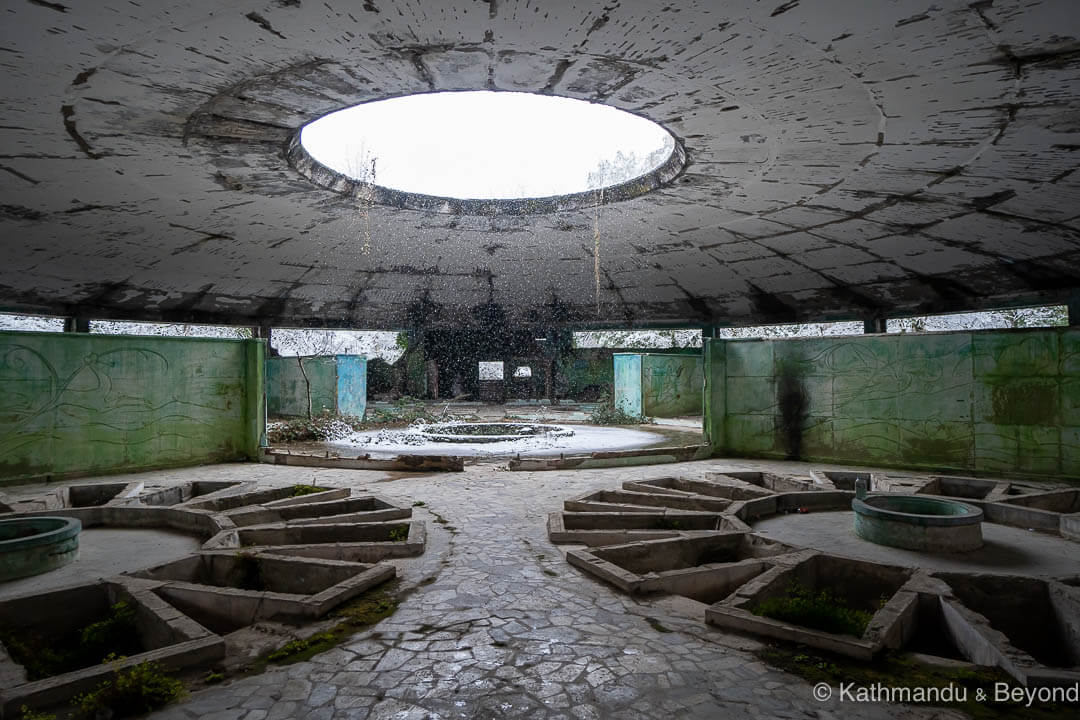
Bathhouse Number 1
Located at the main entrance to the park, Number 1 is another functioning bathhouse. There are some sculptures in front of this bathhouse in the style of Socialist realism.
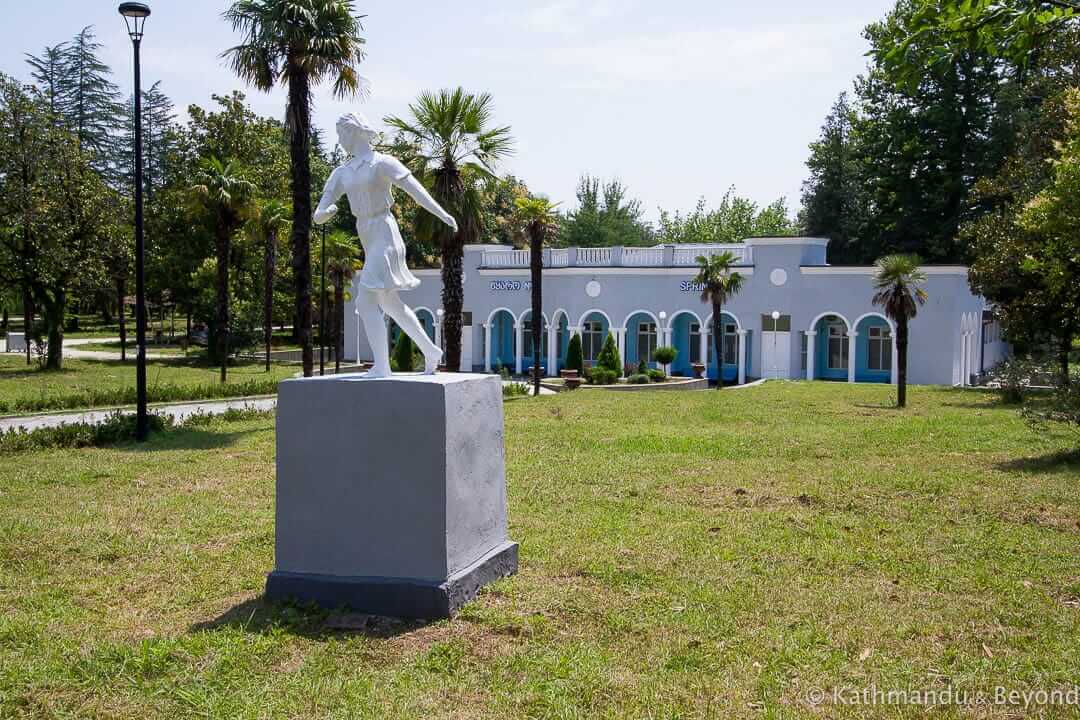
Bathhouse Number 5
Although reasonably impressive from the outside, the interior of Bathhouse Number 5 is wretched. It was pretty awful in 2018 but has deteriorated even more since then. Several of the deep baths are still intact but the yellow and blue tiles that once gave them a splash of colour are difficult to identify anymore as they are so grimy.
Bathhouse Number 4
Bathhouse Number 4 is derelict but also locked so it is not possible to enter. It is positioned just to the right of the main entrance to Number 5.
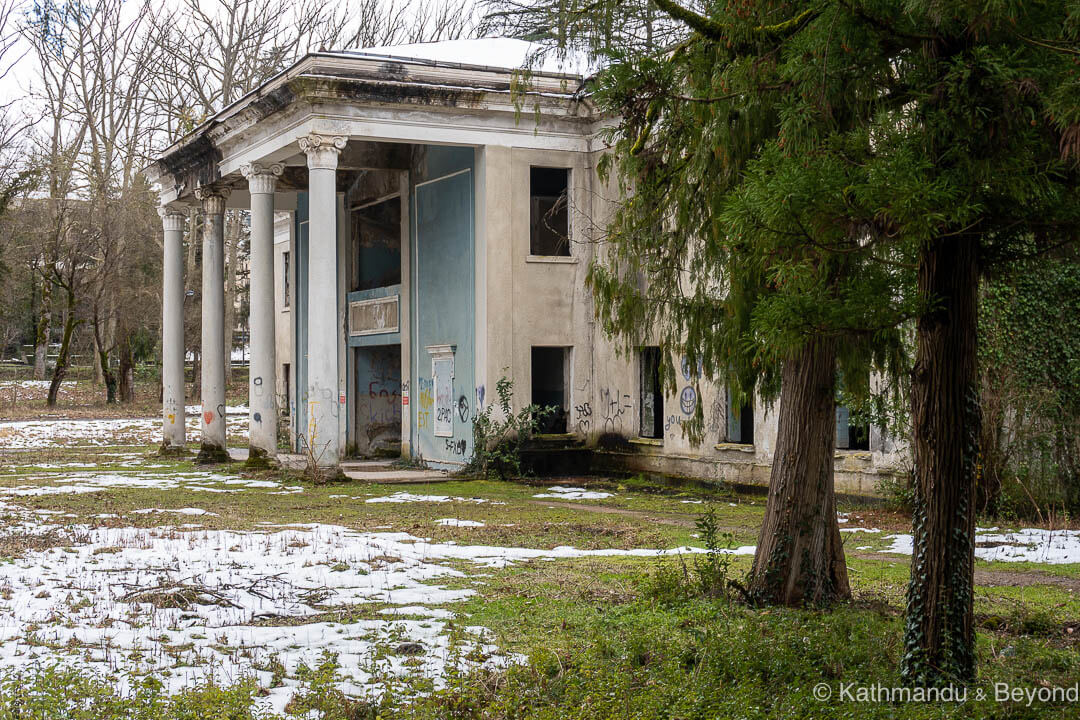
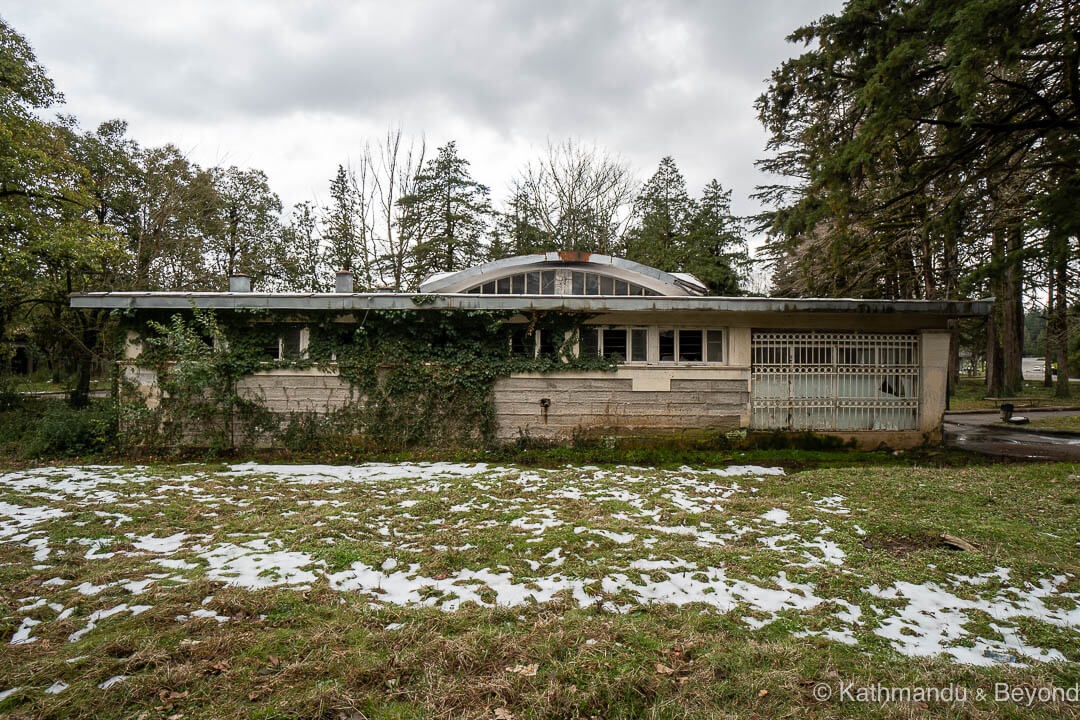
Bathhouse Number 2 (Be Healthy)
Bathhouse Number 2/Be Healthy is a fully functioning spa. The building has either been recently restored or is a new build. It is probably the former as it has elements of Stalin-Empire style design about it. The main reason to visit, unless you want treatments of course, is to see the colourful abstract mosaic-pattern wall to the right of the main entrance.
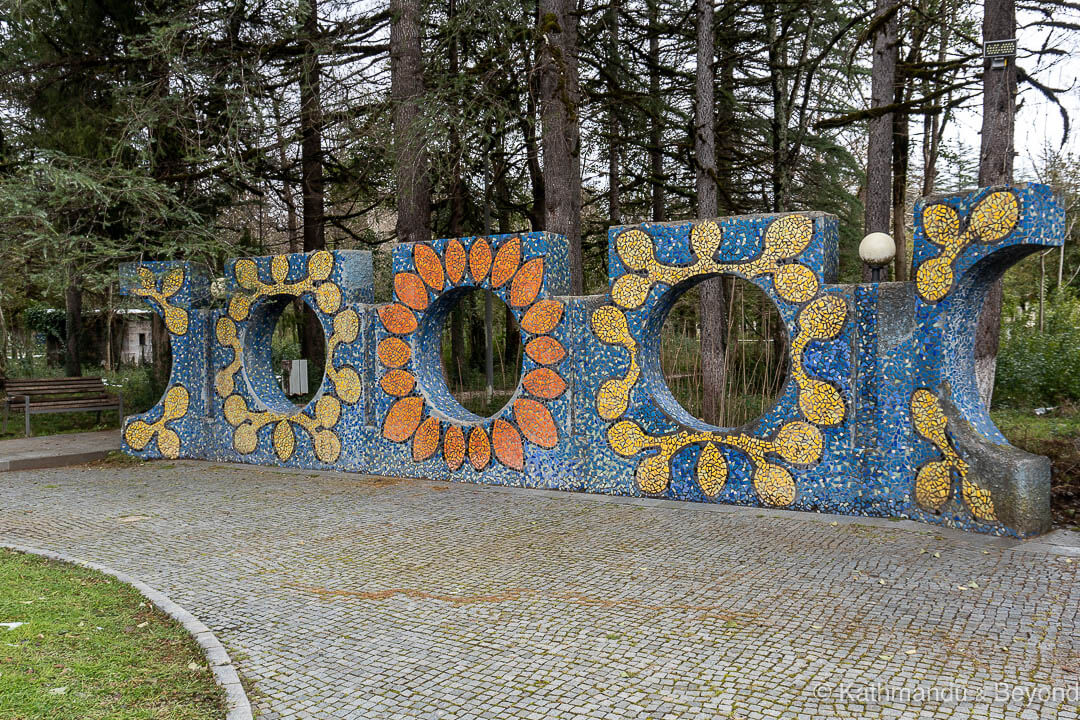
Other Places of Interest in Tskaltubo
Stalin’s Dacha (Holiday Cottage)
The dictator’s dacha is a little way from the centre of Tskaltubo and, given that most buildings on the plot are gutted, there isn’t especially that much to see. But, in our opinion, it is worth visiting for its historical value.
The actual dacha, a two-storey residential villa which seemed fairly modest to us considering it was designed for the leader of the Soviet Union, was built on the grounds of a sanatorium that was for the exclusive use of KGB officials. The villa still retains a few signs of its former grandeur, namely above the front entrance veranda, but, overall, the property is in bad shape.
Away from the dacha, other places of interest include the remains of a bunker (no doubt there was more than one!), a private bathhouse and a mechanical workshop.
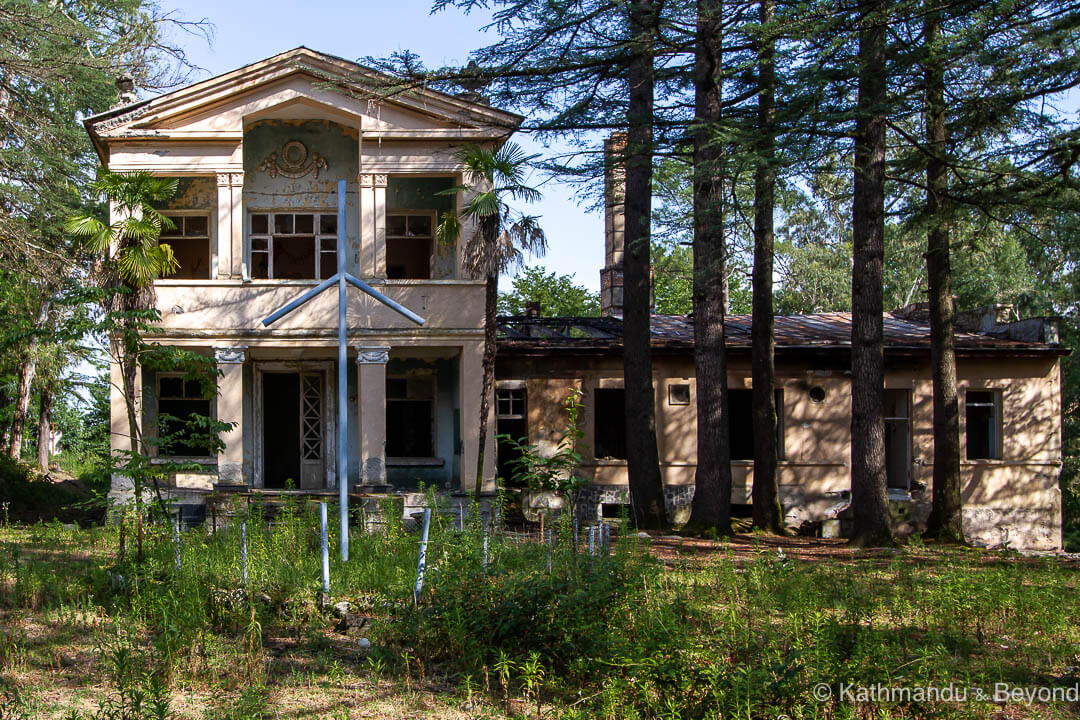
Tskaltubo Railway Station
When we first visited Tskaltubo in 2018, the town’s railway station was being part-restored. The downstairs was used as a community centre and the location of a tourist information desk, which was manned by extremely helpful and enthusiastic staff. The upper floor had been converted into a makeshift bar with crate seats and a big screen to watch the (2018) World Cup football matches. There was even, reportedly, a daily train that rumbled in from Kutaisi, which took 2 hours to reach Tskaltubo and 4 hours to get back!
Forwarding to early 2022 and the station is back to being completely abandoned once more. The tourist board have relocated to another location (not sure where but they can be contacted via their Facebook page), the bar is long gone and we are not sure what happened to the community centre. Plus, there is definitely no train service, if it ever existed in the first place.
It’s a pity, as the railway station is a wonderfully atmospheric building, both inside and out, that has huge potential as a full-on restoration project. As it stands, there are no restrictions on entering the station as well as exploring the overgrown platforms and tracks at the rear of the building.
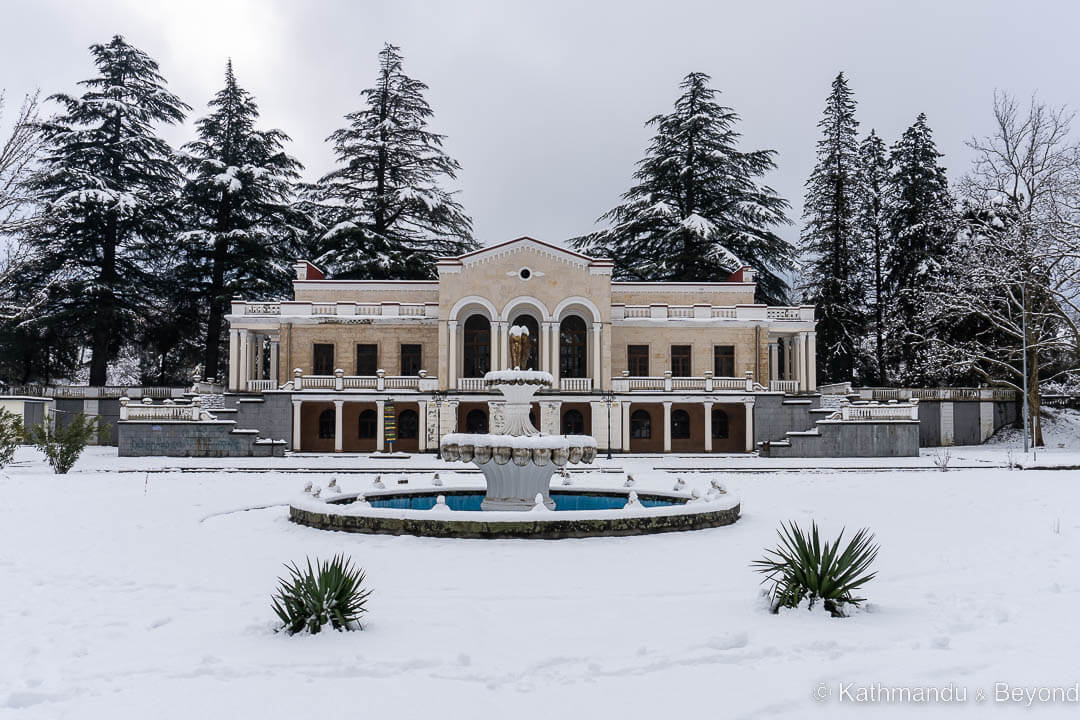
Tskaltubo Central Park (Northern entrance)
This curious monument marks the entrance of the northern route into the park. There is a similar monument at the southern end of the park. They probably date from the 1970s or 1980s.
Unknown Memorial
This unidentifiable memorial is also in the vicinity of the northern entrance to the park. Apart from assuming it was erected during Soviet times, we have been unable to find out what this monument commemorates or represents.
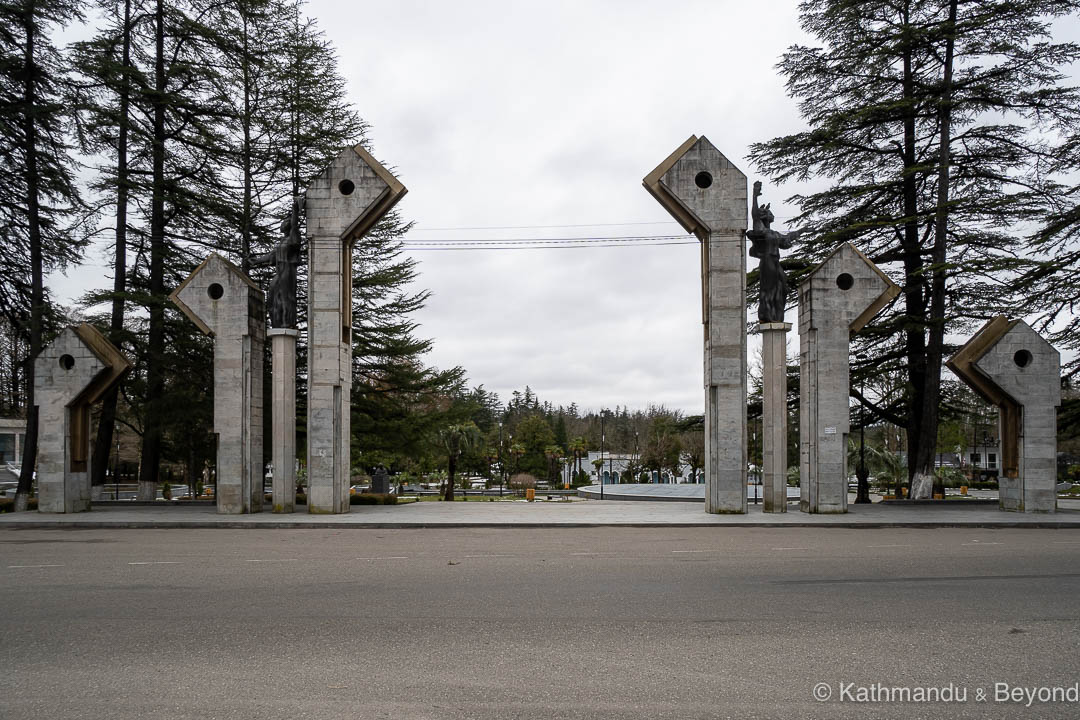
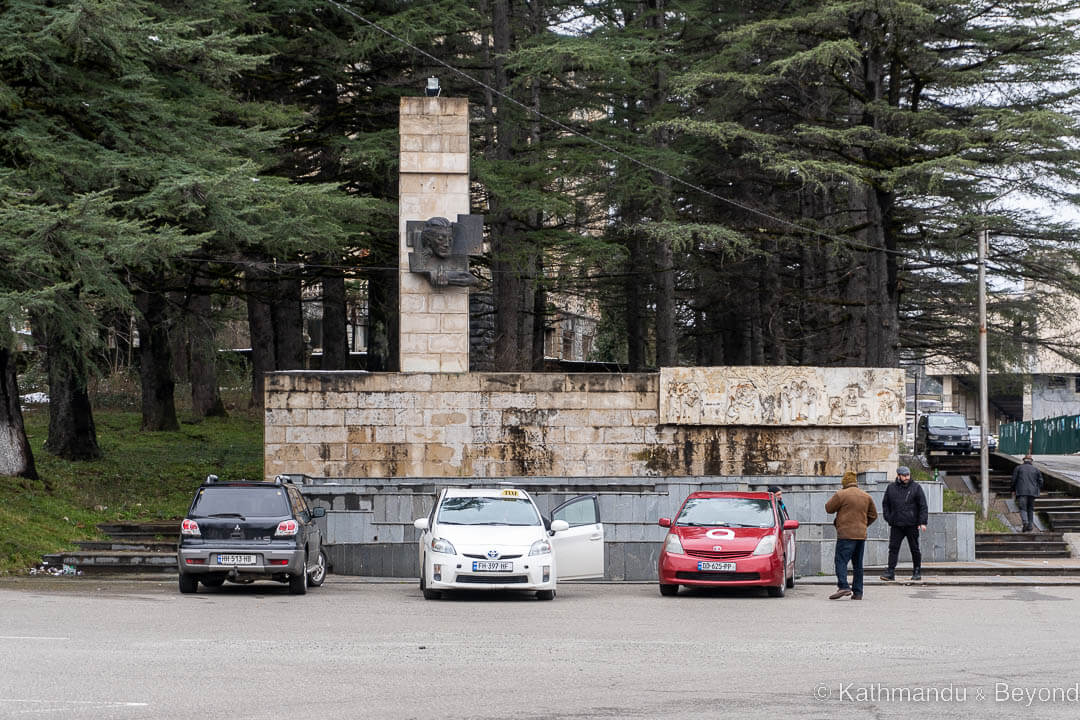
Former Georgian Post building
Located more or less opposite the northern entrance to the park, the building, which dates from the 1970s, functioned as the town’s post office and telecommunications centre until 2013. It is now fully abandoned.
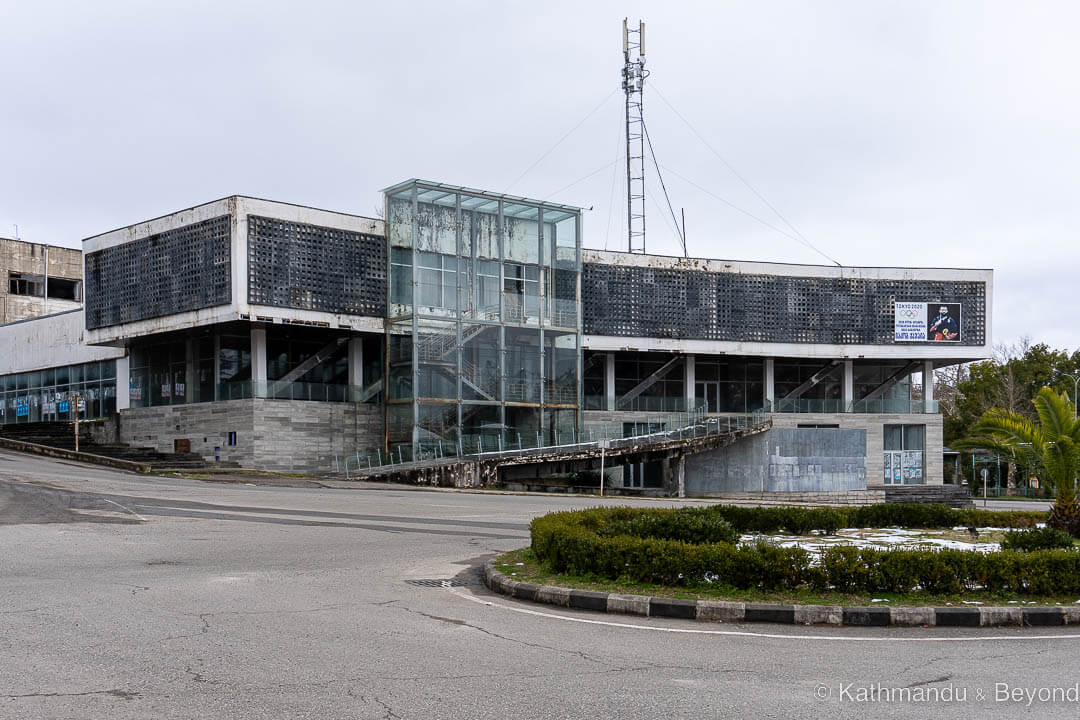
Former Georgian Post depot/telecommunications building
There is an ornate piece of Soviet-era bas-relief on both the western and eastern end of this otherwise nondescript building. The piece on the eastern wall is large and depicts scenes from Georgia’s ancient history. The artwork on the eastern wall, which is not as monumental, is centred around a worker installing cables from the top of a telegraph poll. The building is directly behind the old post office.
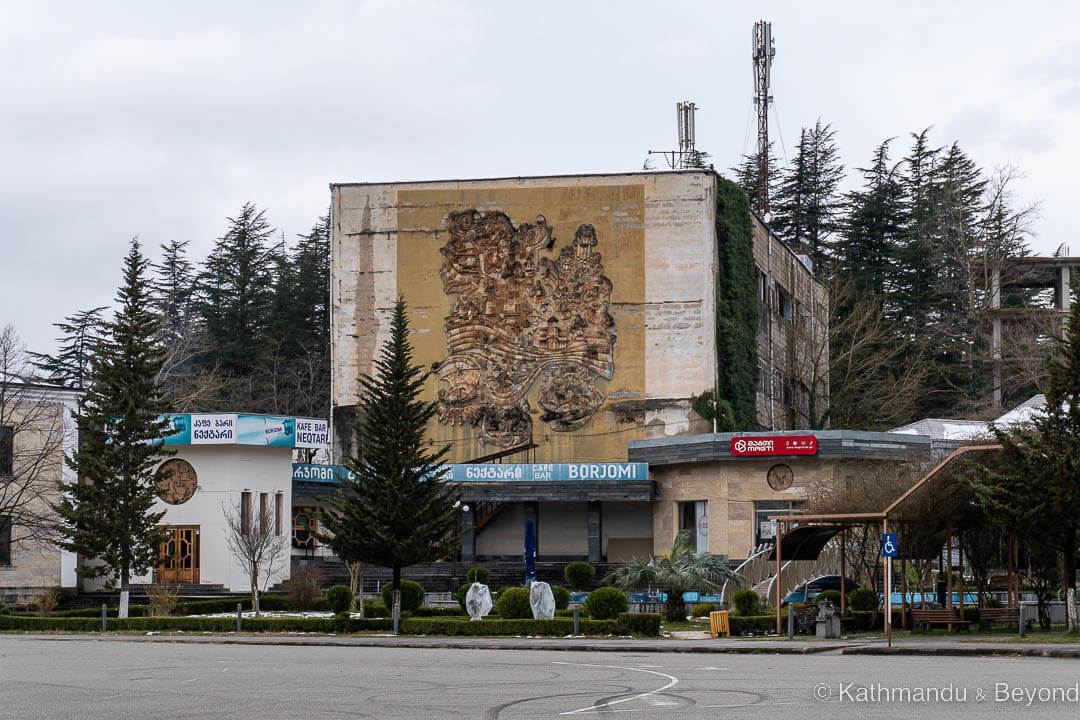
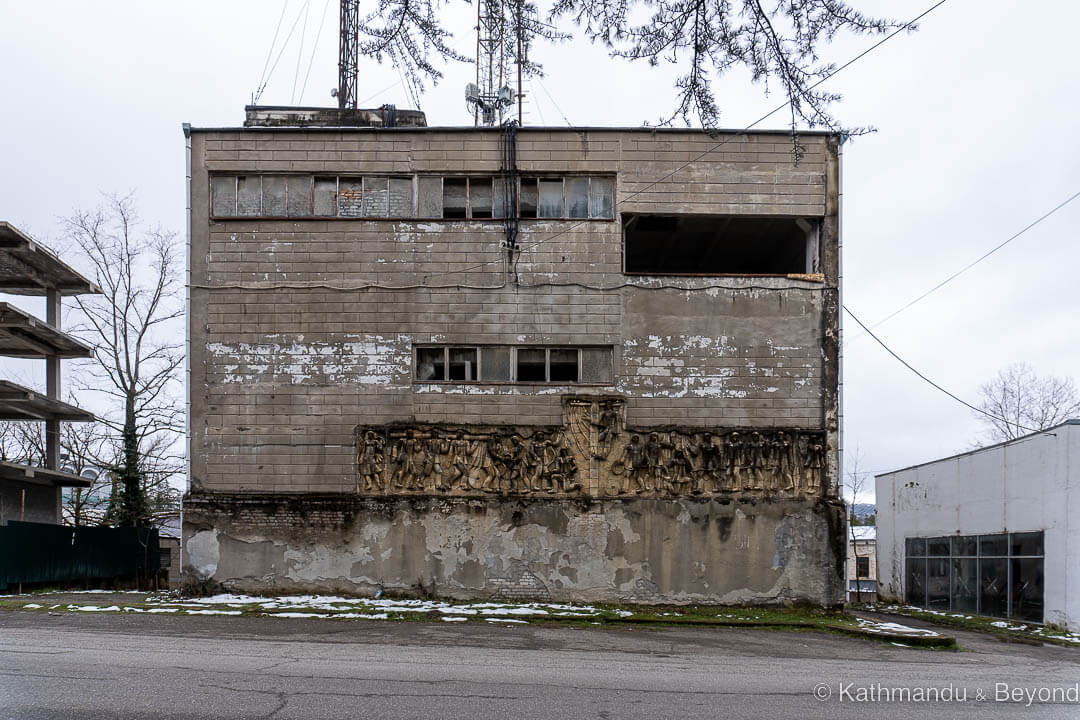
Former Agricultural College
It’s hard to imagine that this was once a college. Apart from being used by vendors now and then, this large example of Soviet Modernist architecture is vacant.
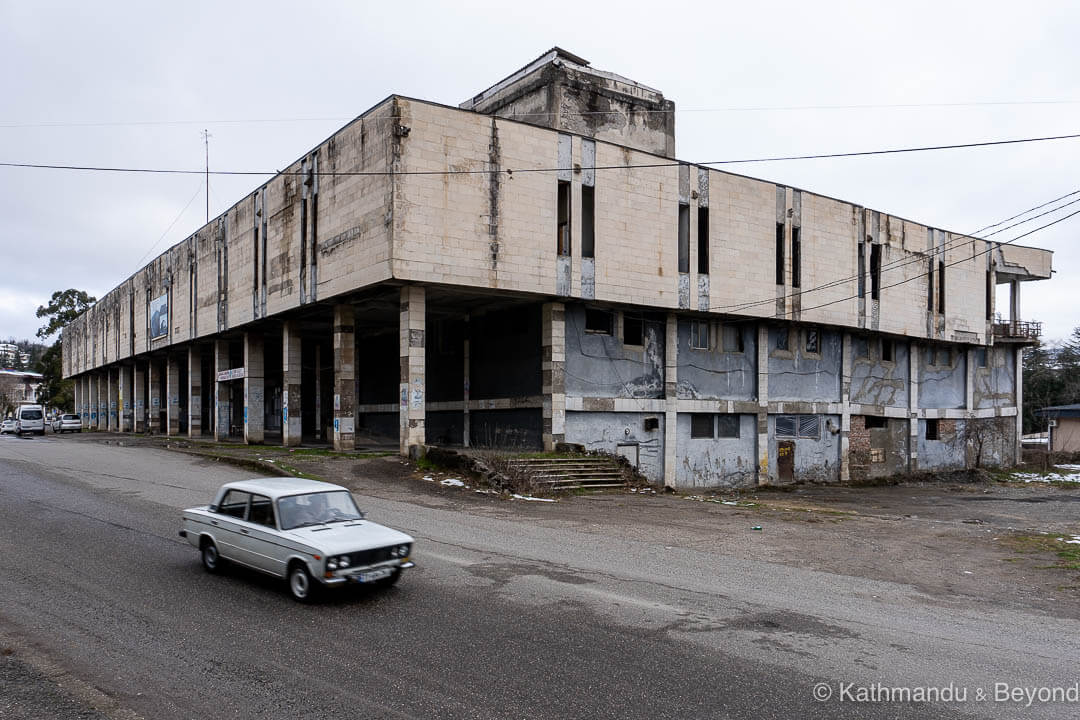
Concert Hall Iveria
The cultural centre likely is one of Tskaltubo’s original buildings but it has been recently renovated (circa 2015).
Unknown Building (Rustaveli Street)
This impressive example of Stalin-Empire style architecture is now divided into a series of retail outlets but it probably had a much grander purpose when it was originally constructed.
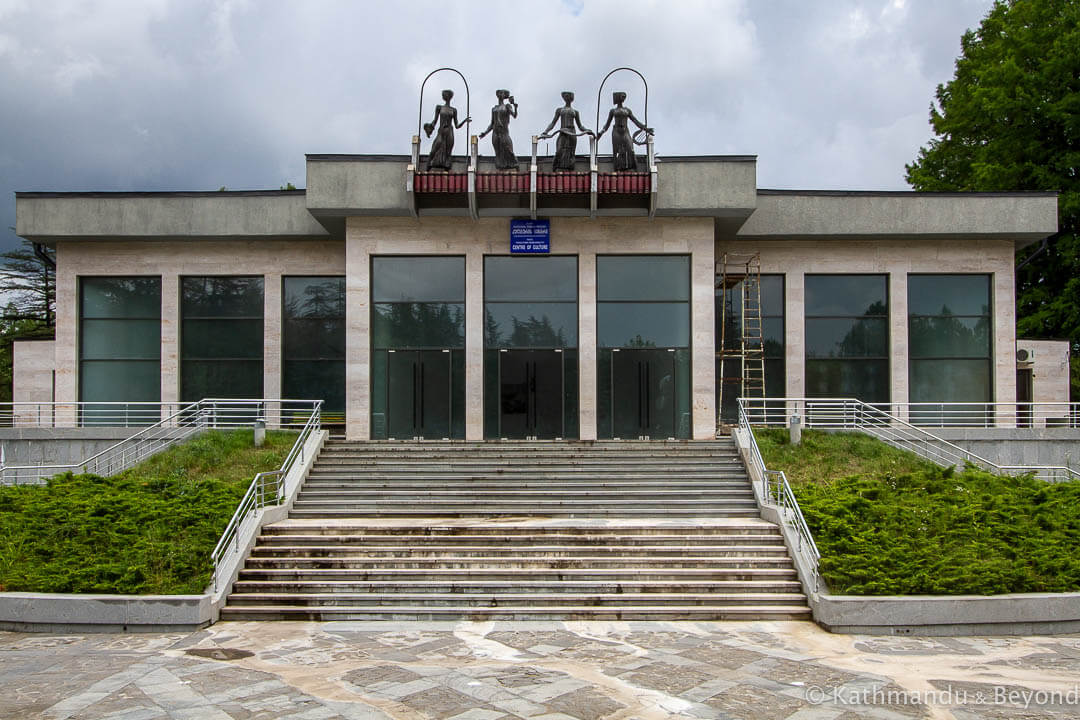
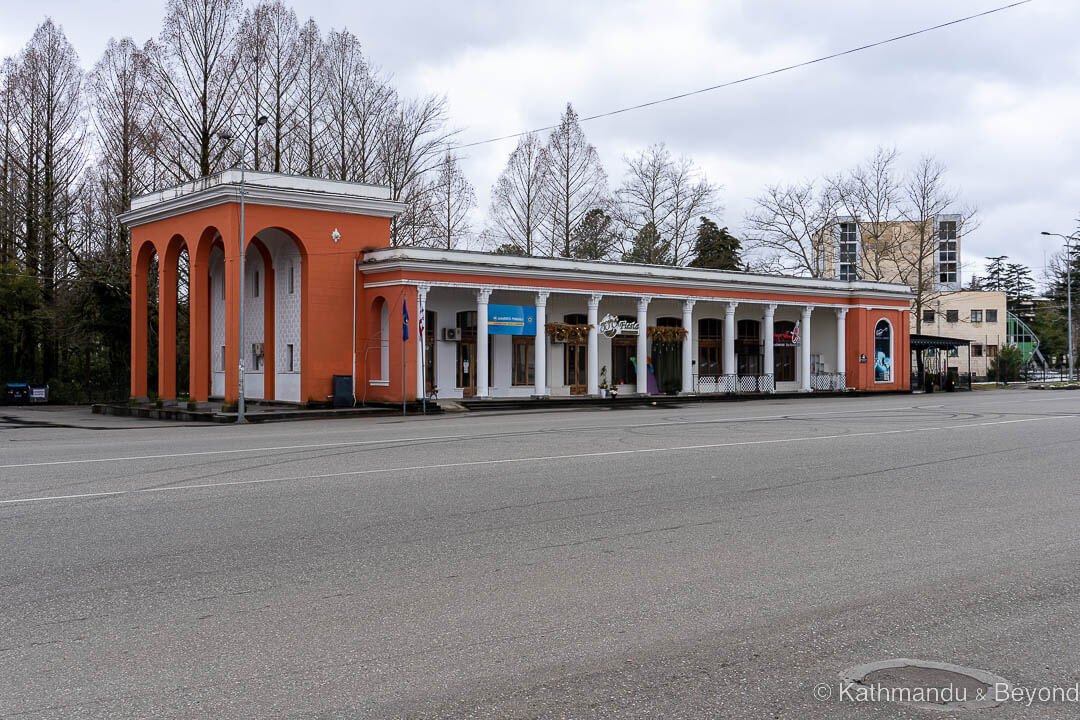
Former Photo Studio
Tucked away in the woods to the right of the European Medical Centre, there is nothing left inside this old photography studio but it’s a nice design and worthy of a quick look.
Unknown Building (Central Park)
Located on the other side of the street from the photo studio, this small structure was probably also a studio of some kind.
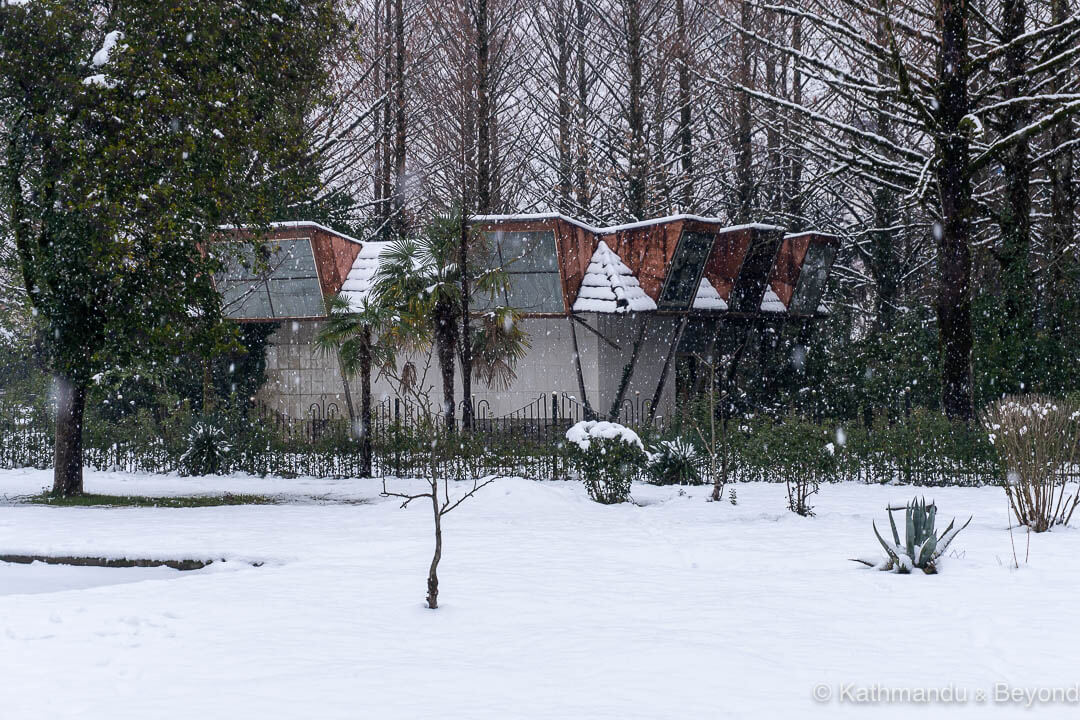
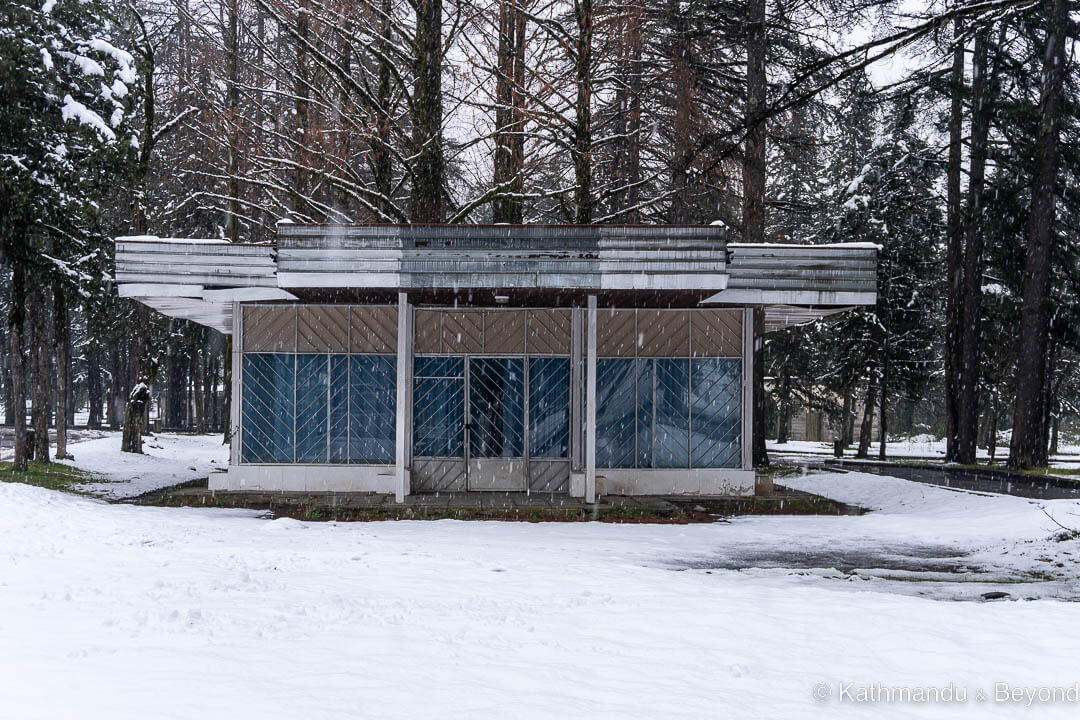
Central Market
If you want proof that Tskaltubo is a working town, then head to the central market. In fact, all you need to do is stay on the marshrutka that brought you here from Kutaisi as they all terminate in the parking lot out the front of the market. The building is an example of Soviet Modernist architecture.
Unknown Building (Imereti Square)
This building, with an unusual entrance, is also a bazaar of sorts. It is another example of Soviet Modernist architecture.
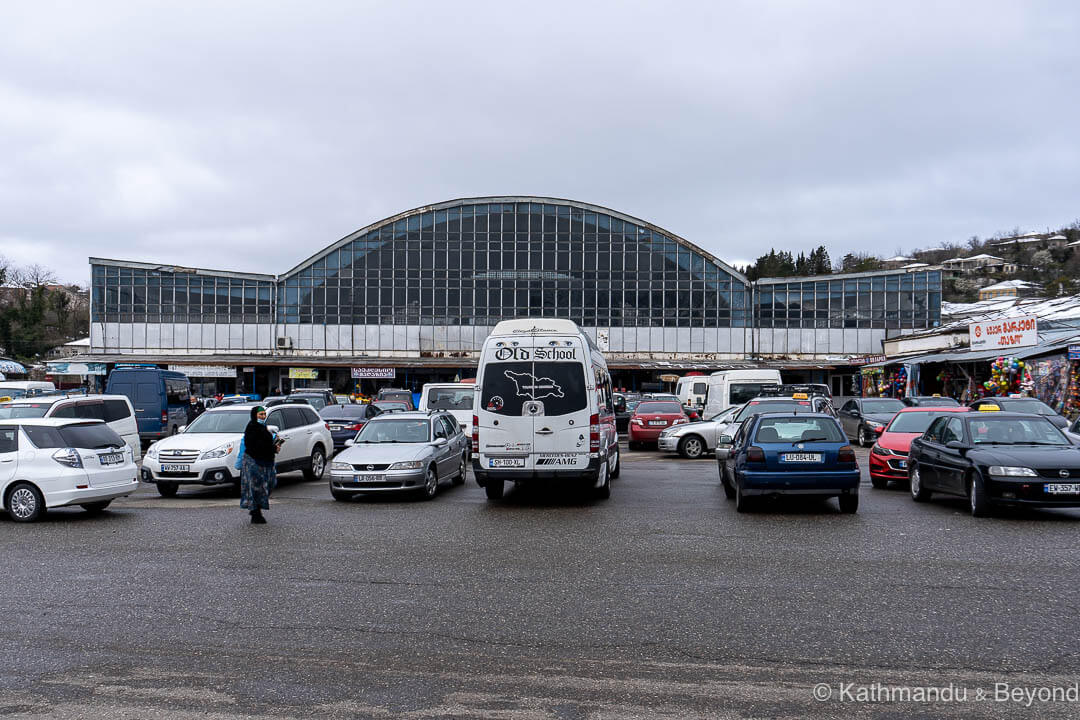
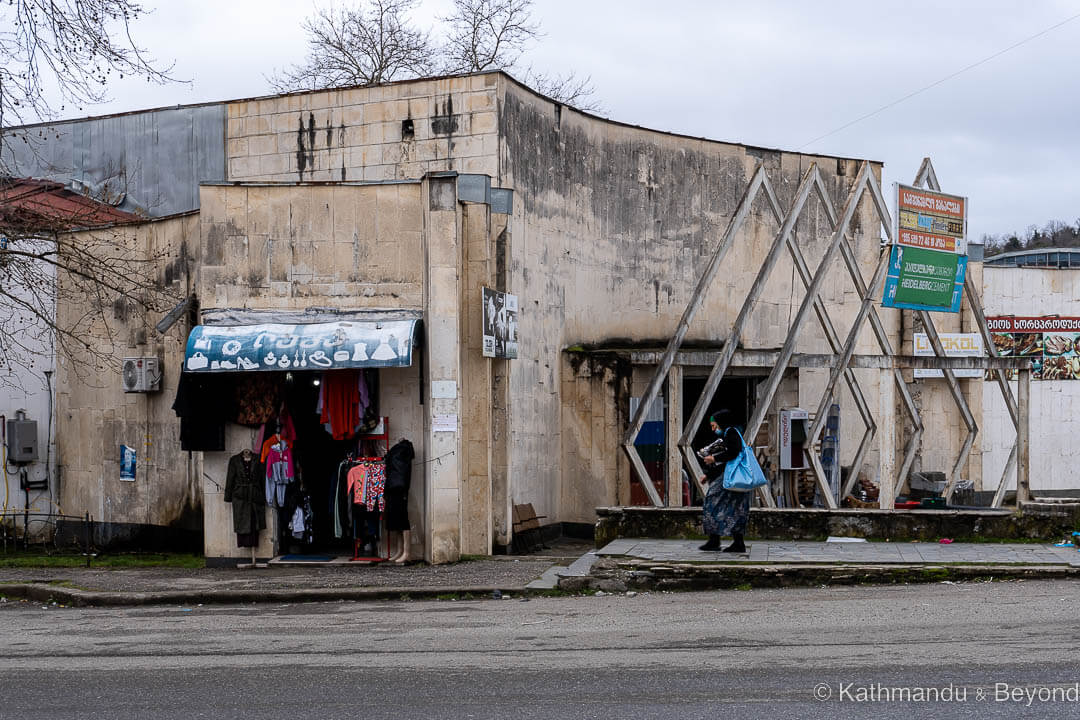
G. Akhvlediani Local Lore Museum of Tskaltubo
We can’t comment on the contents of this museum as it has always been closed when we’ve been there but the building itself is designed in the style of Soviet Modernist architecture. The museum is close to Sanatorium Medea.
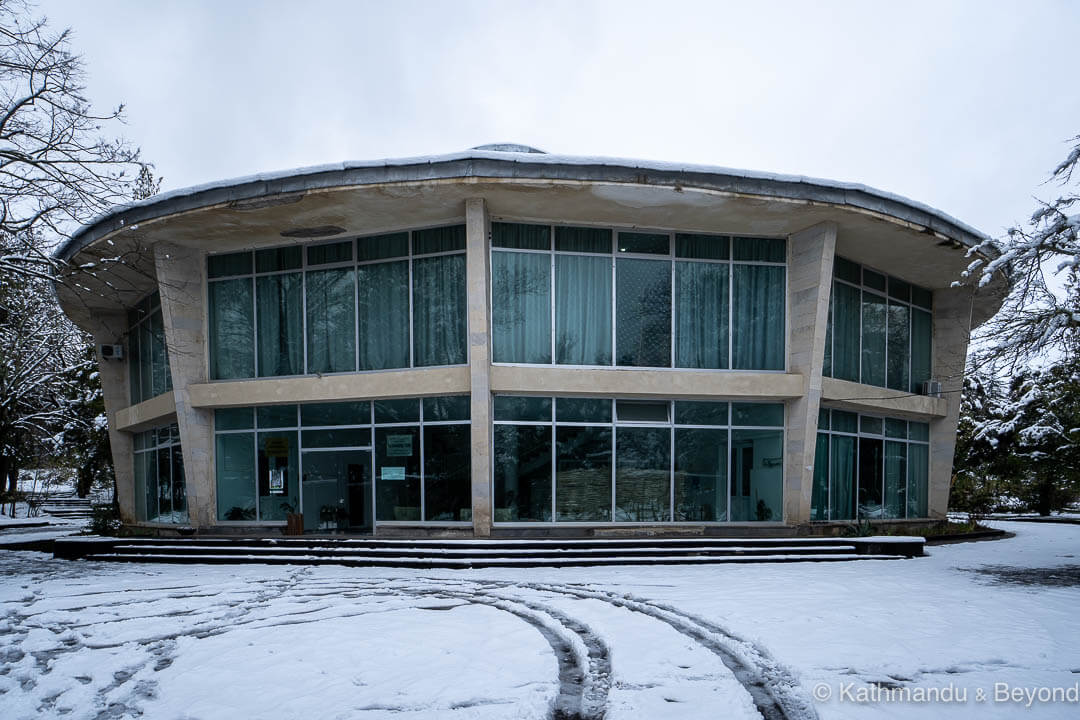
Soviet-era Bus Stop
There are a few Soviet-era bus stops dotted around town. This one is located near Sanatorium Sakartvelo.
Abandoned cinema
There isn’t much to see at this former cinema but it is an easy detour en route between Hotel Savane and the Medical Treatment Centre/Branch of the Research Institute of Resortology/Sanatorium Filiali directly behind it.
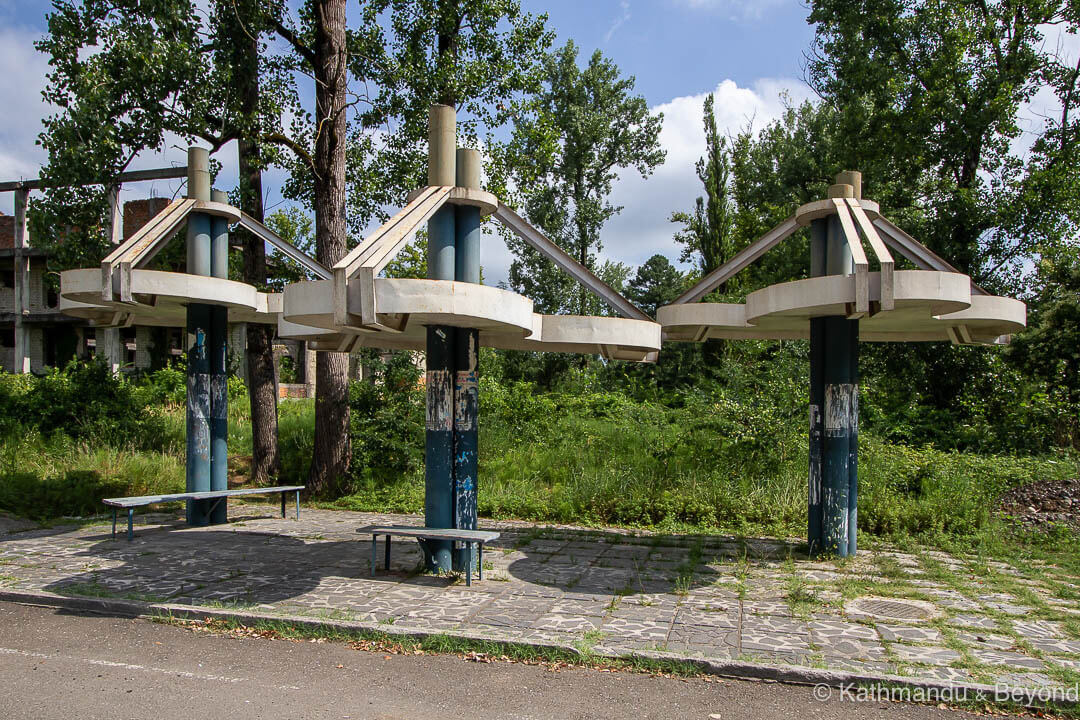
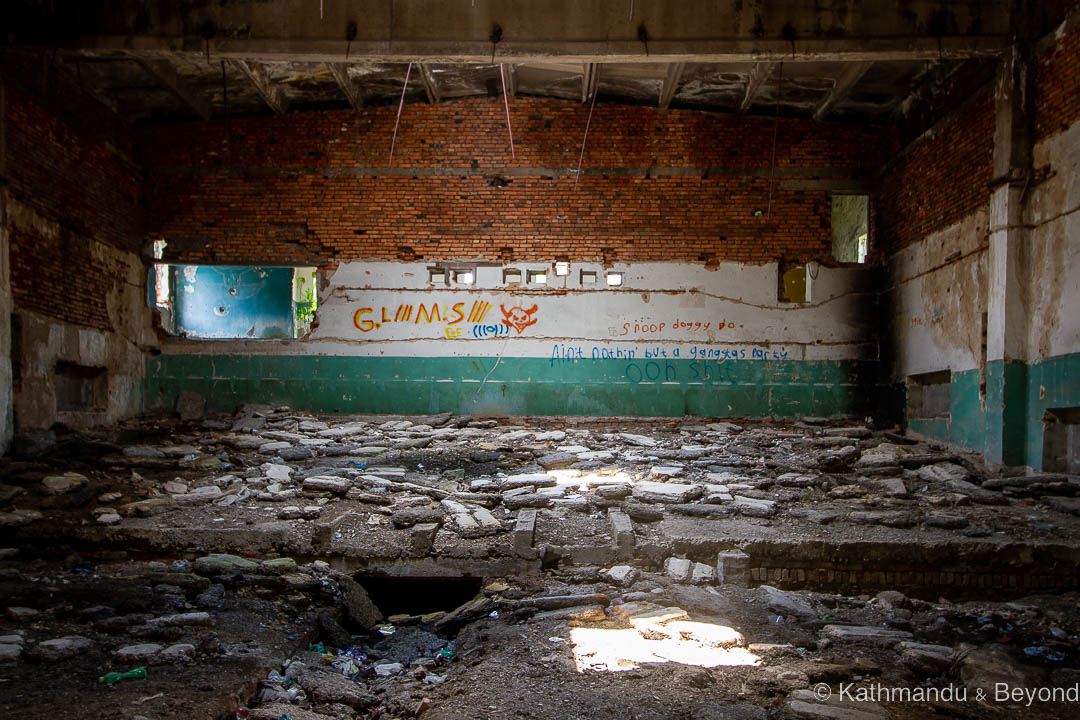
Public Service Hall of Tskaltubo (former Tskaltubo Music School)
Unfortunately, you won’t see this building looking like this anymore as it was renovated in 2020, going into 2021. When we first saw it, the then-abandoned structure was listed as a music school on Google Maps. Looking at a map now, it would seem that the music school has moved to a building at the rear of this one.
For some reason, we neglected to take a photo of the new building but some can be seen by clicking here. It looks like the reconstructed building was given an award for its architectural design.
Tskaltubo Magistrate Court
Just up the road from the public service hall, it is worth stopping by the court to see the bas-relief that decorates the exterior of the building.
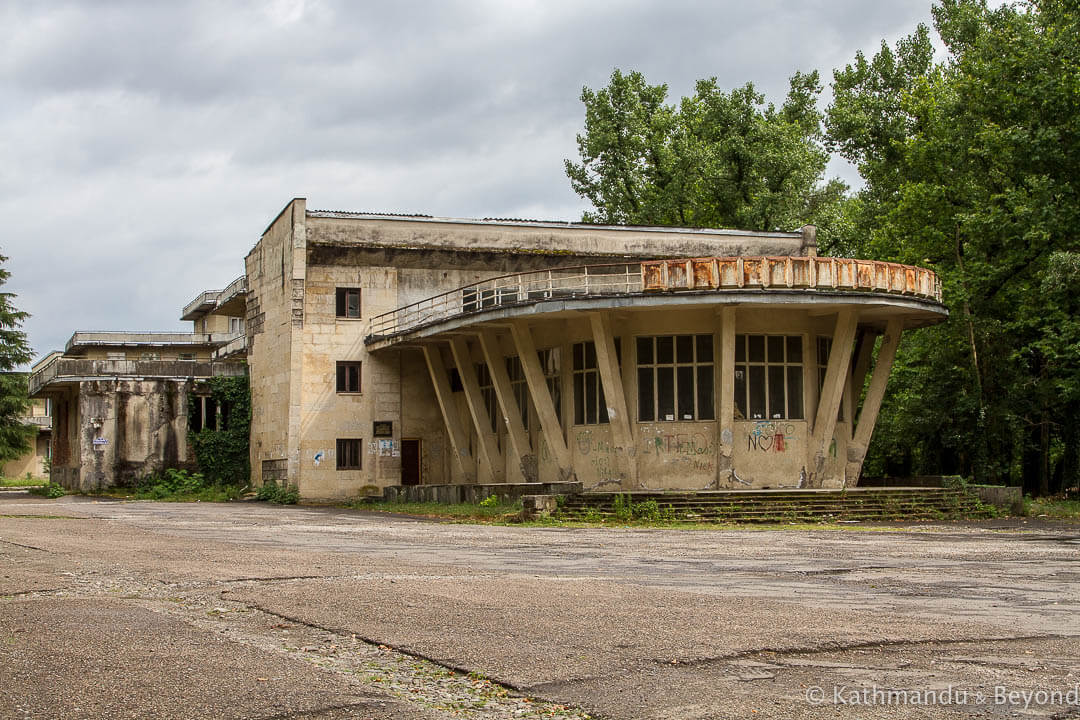
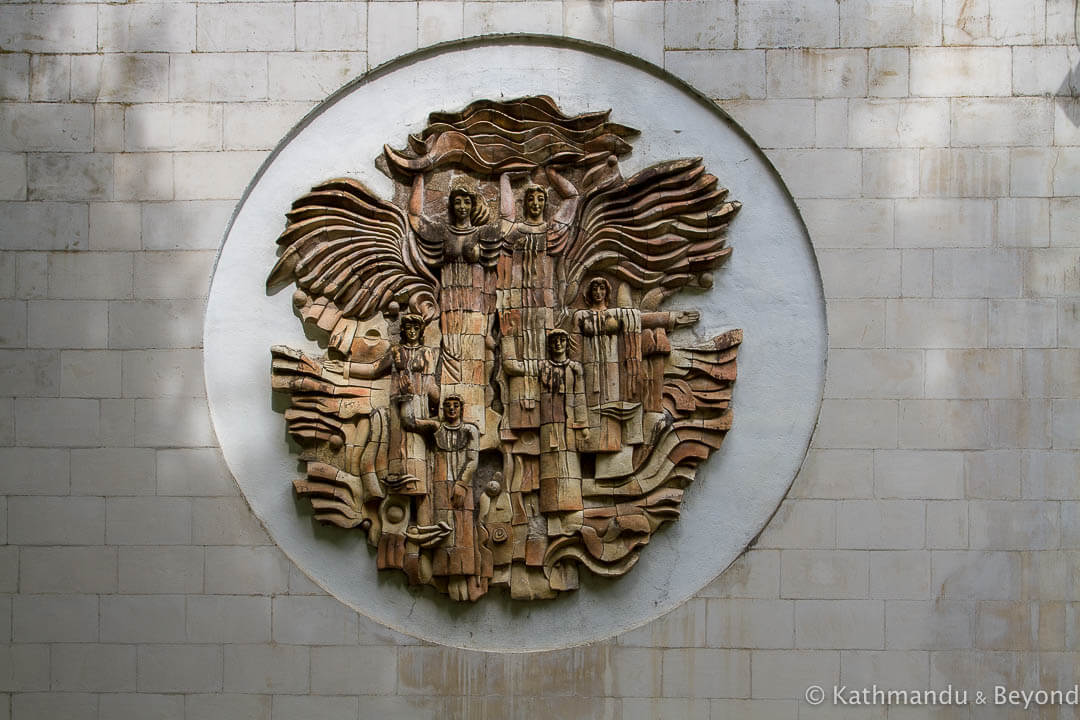
If you enjoyed this post, why not sign up for our newsletter – we’ve got lots more content from Georgia and Armenia coming soon…
IF YOU ENJOYED THIS POST, WHY NOT PIN IT TO YOUR TRAVEL, CAUCASUS OR ABANDONED BOARDS…
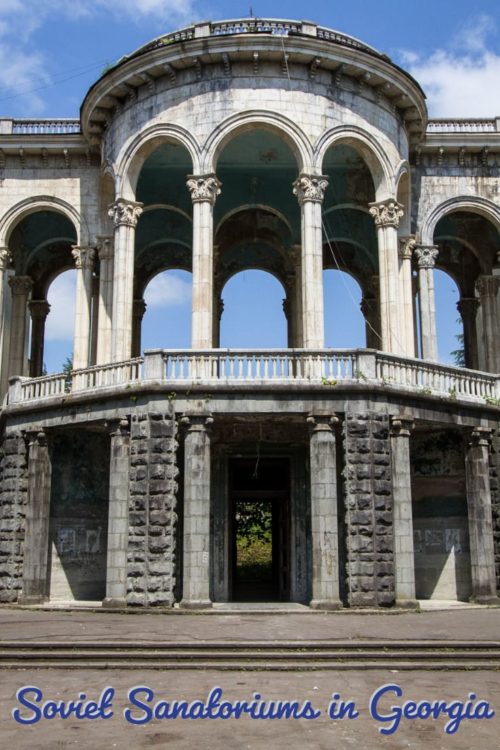
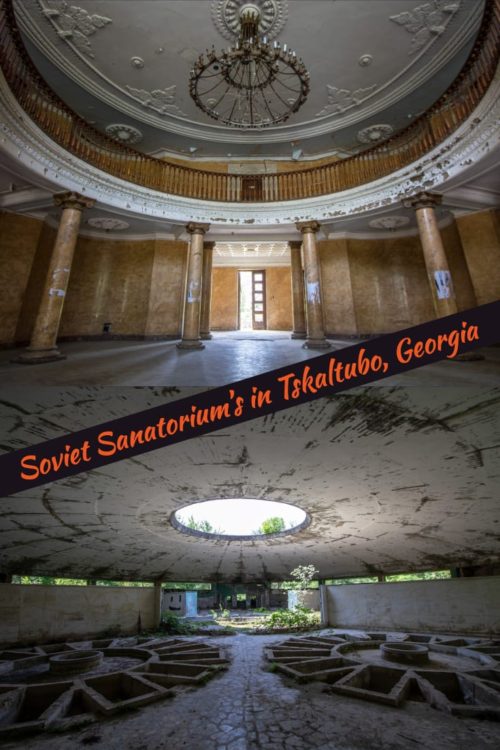
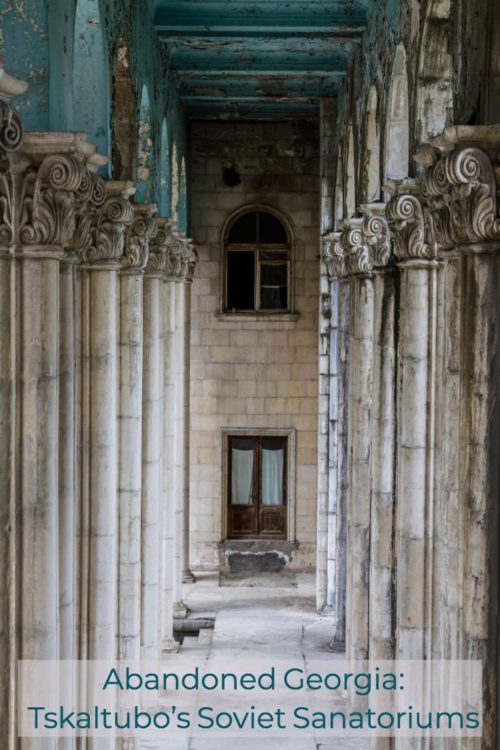
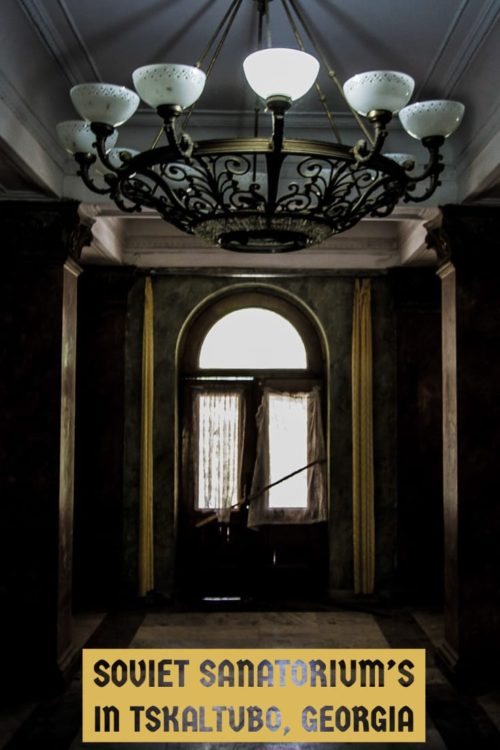

Hey Kirsty & Mark, i have to shout this post is WONDERFUL! I was only spending 30 min in Tskaltubo while we on way to Prometheus cave. My buddy has no interest in UrbEx, So i have to stop him driving to let me get out and explore the Iveria Sanatorium on my own. One of the best thing happened in road trip is accidentally bumped into such gem! Very eerie & heart pumping experience to be alone in that big mansion and wondering what happened in the past. Since then i googled bout it came across the history of santorium. Your post is very informative, almost like a complete guide for Tskaltubo! I fully agree with you the tourism voyeurism at the occupied space. I think if we able to get a translator to express the intention of knowing their story with permission for taking picture of their daily living space,that would be a good piece of journalism material instead of just fulfilling our own curiosity. I feel regretted not taking an tea offer at the place of a very friendly grandma met at Chiatura cable car station. ; )
Anyway, i have liked your FB page (real name is Enig Hui). Enjoy reading your blog very much!
Firstly, huge apologies for the incredibly late response to your comment. I just found it in the ‘bin’ folder, not spam but straight to the bin and I’ve no idea why. I feel embarrassed to be replying so late, you must have thought us incredibly rude!
Anyway, I’m happy that you were able to explore some of Tskaltubo’s hidden gems. You are right about taking a translator to allow a communication flow and to really be able to find out more about the lives of those living there.
Tea with the babushka in Chiatura could have been fun, especially if like us, the cable car broke down and we had a lot of time to kill waiting!
Hi, This was such a interesting post! Actually we visited at Tskaltubo in june too! Sadly before this post was published, so we didnt know all these things 🙁 We accidentally went to Tskaltubo Spa Resort for one night and it was amazing. So sad we didnt discover more of these hidden beauties.. Hopefully can go back someday. I actually have one drone shot from Tskaltubo resort what looks similar than the first photo you have. Im writing a finnish Travelblog and if its okay, i would like to use few of your pics and ofcourse link your website there too! You had such a amazing history in this post! I will let you know after i have published it.
Sandra
https://www.terveisetpaivantasaajalta.com/single-post/tskaltubo-spa-resort-neuvostoliiton-aikainen-hylatty-kylpylakaupunki
Link to my post about this Place 🙂
I’m happy to hear that you found Tskaltubo as fascinating as we did! I tried to send you an email but it bounced back…
This place sounds amazing and the history is crazy, thanks for this writeup! I’ll be in Kutaisi next week and was hoping to visit Tskaltubo, is it easy to spot the sanitoriums when you get into the town?
Thank you for your comment and I hope my reply isn’t too late – we’ve had a hectic few days! Many of the hotels and sanatoriums are easy to find as they form a ring around the park. If you’re arriving by bus/marshrutka from Kutaisi, keep an eye out as you come into town and you’ll see some and it will help orientate you. I’ve sent you an email, so check your inbox 🙂
Hey, You missed one of the biggest semi – abandoned ones here.
Which one?
It is/was called Imereti Sanatorium. It is distinctive as it has a yellow and blue dome with columns and a stunning trio of staircases.
Ah! We had the name of that one, but kept getting conflicting information about its exact whereabouts and which one it was – it was surprisingly hard to identify the names of many of the buildings! And, damn it! That’s beautiful. Looks like we’ve just found ourselves a reason to go back to Georgia! 🙂
Thank you very much for this. I stayed in Tskhaltubo in 1986 during a college tour of the USSR and returned to visit the dilapidated sites in 2013. In 2013 I stayed in the one functioning hotel mentioned above. A little note: The hotel you identify as the “Intourist Hotel” was actually called the “Motel Tskhaltubo” (the sign is still visible at the top of the building). That was where I stayed in 1986.
Wow, it must have been fascinating to see back in the ’80s. Do you have any photos from that time?
Thanks, for the heads up on the Intourist Hotel – I’ll update the post.
I have a handful of pictures, postcards and a brochure. Would be happy to share.
That would be amazing, thank you. I’ve sent an email to you via the email you included in your comment, so you will have my email address.
Hi, I found this your comment just now, but I am working on a documentary of Tskaltubo, I have an exhibition about the topic last year in Tbilisi, too: https://abandonedrecreation.com/permanentna-rekreacia/ and I am really interested in the photos that you have from 1986. It would be possible to share? I am mostly interested in personal photographs. Thank you very much. Andrea
Thank you. I thoroughly enjoyed the article!
You’re welcome. Happy to hear that you enjoyed the post. Have you visited Georgia?
Hi; Great article . I used a lot of info for my visit to Tskaltubo late May this year but the hotel on the black and white picture is the Tskatubo Spa Resort Hotel and not the Shaxtiori . I stayed 2 nights in the Tskaltubo Spa resort hotel . I’ve chosen that one just to be sure to have the oppourtunity to photograph the abandoned part (which I did 🙂 ) . I’ve spent 2 days in Tskaltubo and didn’t find the Gelati . There’s a plan for revitalising Tskaltubo : some construction already on their way . So if you want to photograph the beauty of the decaying beauty of the sanatoria , bath houses or hotels I advice you to do it rather sooner then later. I’m going back in September . Greets Dominiek.
Thank you Dominiek, really happy you found the post useful. And thank you for pointing out my mistake regarding the old photo of the Tskaltubo Spa Resort, Originally I was thrown by the incorrect labelling of the image on Wiki and I’d thought all of the buildings in the photo were different sanatoriums. But looking at it again, I can see it! It must have been a great experience staying there.
You’re right about the pace of change that seems to be underway in Tskaltubo – the Iveria is now out-of-bounds, and it might only be a matter of time before others follow. Enjoy your return visit, 😉
Finally, apologies for the late reply.
Great post! We are going to Tskaltubo in 4 weeks and I am planning to visit some of the buildings as well. This article was very helpful to find a lot of them on Google Maps. I am curious if you could tell me where to find the Dacha of Stalin? If you don’t want to publish it on your website, maybe you could send me an email with the lat/long? Thanks already!
I saved this post until I finally had the chance to visit Tskaltubo, today! It was very helpful so thanks for all the work and the info you provided.
Iveria Is fenced off, but there was a gap and no guards in sight, so I’m glad we got to see this one before any development.
Everyone we came across in occupied buildings were very friendly, we just stayed away from any living areas.
That’s great. Thank you for letting us know. Very happy to hear that you had a good experience, and also that you managed to get a glimpse of Iveria 🙂
Very interesting.
We visited yesterday with a Kutaisi local.
Was amazing!
Isn’t it? I just hope that, as more and more of the properties get sold off, there will be an effort to retain the original features in many of the buildings. It would be sad to see that disappear.
Wonderful post but above all THANK YOU for disclosing the locations of all these places.I hope i will be able to visit them without being stopped by locals or security guards as i will be visiting Georgia next week 🙂
Thank you and happy that you found it helpful. Good luck with your exploration – we hope you get to see as much as possible.
Do let us know how you get on. There is talk of many of the old sanitoriums being redeveloped and things like access can change so feel free to drop any updates here. Happy travels!
Locals who live in Metalurgi are asking for 5 lari per person to walk in. There are running water pipes and power wires installed atop the building walls for those who live inside. The former theater is open, with one row of seats inside.
That building is not Stalin’s dacha – it’s known as “Hotel #2” and was a sanitorium. The dacha is further north on top of the hill – google maps has the correct location.
This complex is now owned by a private investor and guards shop tourists away. It’s on the Georgian’s government master plan for redeveloping Tskatubo.
Hello Victor, apologies for the delay in replying. I have crossed checked the location of the dacha on our map with that on Google Maps, and they are both the same. Thank you for the update regarding access to the dacha.